
This is a very posh family which we will explore in this post!
As far as I know it has little ethnobotanical uses but we all admire the members of this huge worldwide family!
“Along with the Asteraceae, they are one of the two largest families of flowering plants. The Orchidaceae have about 28,000 currently accepted species, distributed in about 763 genera worldwide.”
Stace mentions 22 straight genera growing in the British Isles. There are also many intergeneric crosses, which makes the classification a lot more complicated. Some genera only have a limited number of species, whilst Dactylorhiza (Marsh orchid), Epipactis (Helleborine) and Orchis (Orchids) have many species.
There are 15 entries in our Flora of Birmingham and the Black Country although some are old records and have not been seen in recent years. These entries will be indicated by FBBC after the name in the contents page.
If you are interested in native orchids you can also have a look at the website of The Hardy Orchid society, who share an interest in the wild, native orchids of Britain and the rest of Europe, as well as those from similar temperate climates throughout the world.
The Scientific name in the post will have a link of the ‘Online Atlas of the British and Irish Flora’ from which I copy the Ecology/habitat in the B.I. You will be able to find out the frequency it occurs on the British Isles with the map.
The common name usually has a link of Wikipedia or another link of a U.K. site. I’ve used the excellent website First Nature on several occasions. This also has a useful Wild Orchids of Britain and Ireland Gallery.
The info about wildlife associated is mainly from Wikipedia.
Most orchids require a mycorrhizal symbiosis to germinate successfully and remains partially dependent upon the fungus in order to access soil nutrients. This information can also be found in the Wikipedia link and I will omit this in order to keep the information concise.
Pictures are mainly thanks to Mike Poulton (M.P.), Andrew Bennett (A.B.), Matt Summers (M.S) and from various people on Wikipedia.
Contents:
In Stace it is family 164 after the Liliaceae and before the Iridaceae. The family is split into 7 tribes which you can find in the contents below and please use the jump link to find more info on the next page!
Tribe 1 CYPRIPEDIEAE
Cyprepedium calceolus or Lady’s-slipper
Tribe 2 NEOTTIEAE
- Cephalanthera damasonianum or White Helleborine
- C. longifolia or Narrow-leaved Helleborine
- C. rubra or Red Helleborine
Epipactis spp or Helleborines (8 species and several hybrids in Stace):
- Epipactis helleborine or Broad-leaved Helleborine (FBBC)
- E. atrorubens or Dark-red Helleborine
- E. purpurata or Violet Helleborine (FBBC)
- E. muelleri var muelleri or Narrow-lipped Helleborine
- E. phyllanthes or Green-flowered Helleborine (FBBC)
- E. palustris or Marsh Helleborine
Neottia spp or Twayblades (3 species in Stace)
- N. ovata or Common Twayblade (FBBC)
- N. cordata or Lesser Twayblade
- N. nidus-avis or Bird’s-nest Orchid
Tribe 3 GASTRODIEAE
Epipogium aphyllum or Ghost Orchid
Tribe 4 MALAXIDEAE
Liparis loeseli or Fen Orchid
Hammarbya paludosa or Bog Orchid
Tribe 5 CALYPSOEAE
Corallorhiza trifida or Coralroot Orchid
Tribe 6 CRANICHIDEAE
Spiranthes spp. (3 spp in Stace)
Spiranthes spiralis or Autumn Lady’s-tresses
S. romanzoffiana or Irish Lady’s-tresses
Goodyera repens or Creeping Lady’s-tresses
Tribe 7 ORCHIDEAE
This is the most common tribe in the BI with 11 genera mentioned in Stace. It is also complex with many intergeneric crosses.
Hermenium monorchis or Musk Orchid
Plathanthera spp or Butterfly-Orchids
- P. chlorantha or Greater Butterfly-orchid
- P. bifolia or Lesser Butterfly-orchid
Pseudoorchis albida or Small-white orchid
Gymnadenia spp or Fragrant orchids
- G. conopsea or Fragrant Orchid (FBBC)
- G. densiflora or March Fragrant Orchid
Coeloglossum viride or Frog Orchid
Dactylorhiza or Marsh-orchids(Stace mentions 8 spp as well as many ssp & hybrids!)
- D. fuchsii or Common Spotted-orchid (FBBC)
- D. x grandis (D. fuchsii x D. praetermissa) (FBBC)
- D. maculata or Heath Spotted-orchid (FBBC)
- D. praetermissa or Southern Marsh-orchid (FBBC)
- D. incarnata or Early Marsh-orchid (FBBC)
- D. purpurella or Northern Marsh-orchid (FBBC)
- D. traunsteinerii or Narrow-leaved Marsh-orchid
- D. majalis or Western (Broad-leaved) Marsh-orchid
Orchis spp or orchids
- O. mascula or Early-purple Orchid (FBBC)
- O. purpurea or Lady Orchid
- O. simia or Monkey Orchid
- O. militaris or Military Orchid
- O. ustulata or Burnt Orchid
- O. anthropophora (Syn. Aceras anthropophorum) or Man Orchid
Neotinea maculata or dense-flowered orchids
Anacamptis pyramidalis or Pyramidal orchid (FBBC)
Anacamptis moria (syn. O. moria) or Green-winged Orchid (FBBC)
himantoglossum hircinum or lizard orchid
Serapias parviflora or Lesser tongue-orchid
Ophrys spp or bee orchids
- O. apifera or Bee Orchid (FBBC)
- O. fuciflora or Late Spider-orchid
- O. insectifera or Fly Orchid (FBBC)
- O. speghodes or EarlySpider-orchid
O. tenthredinifera or Sawfly-orchid
O. insectifera x O. apifera = O. x nietzsche.
Tribe 1 CYPRIPEDIEAE
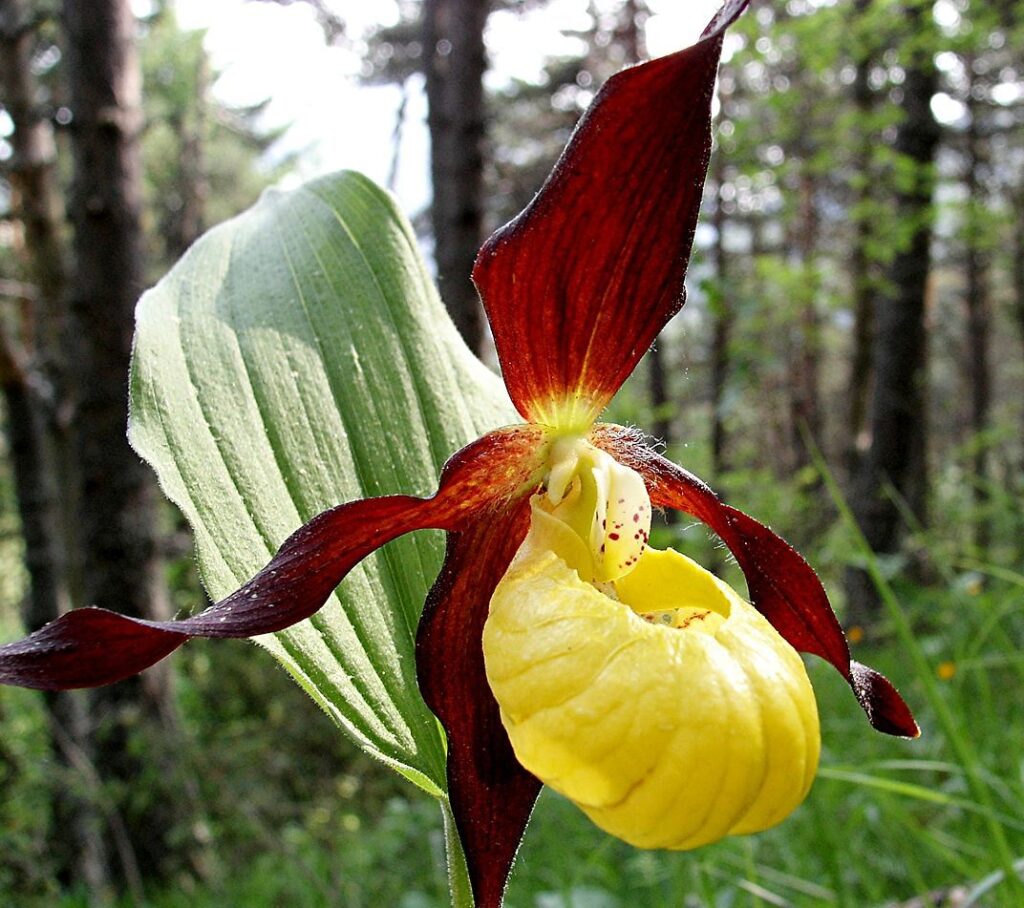
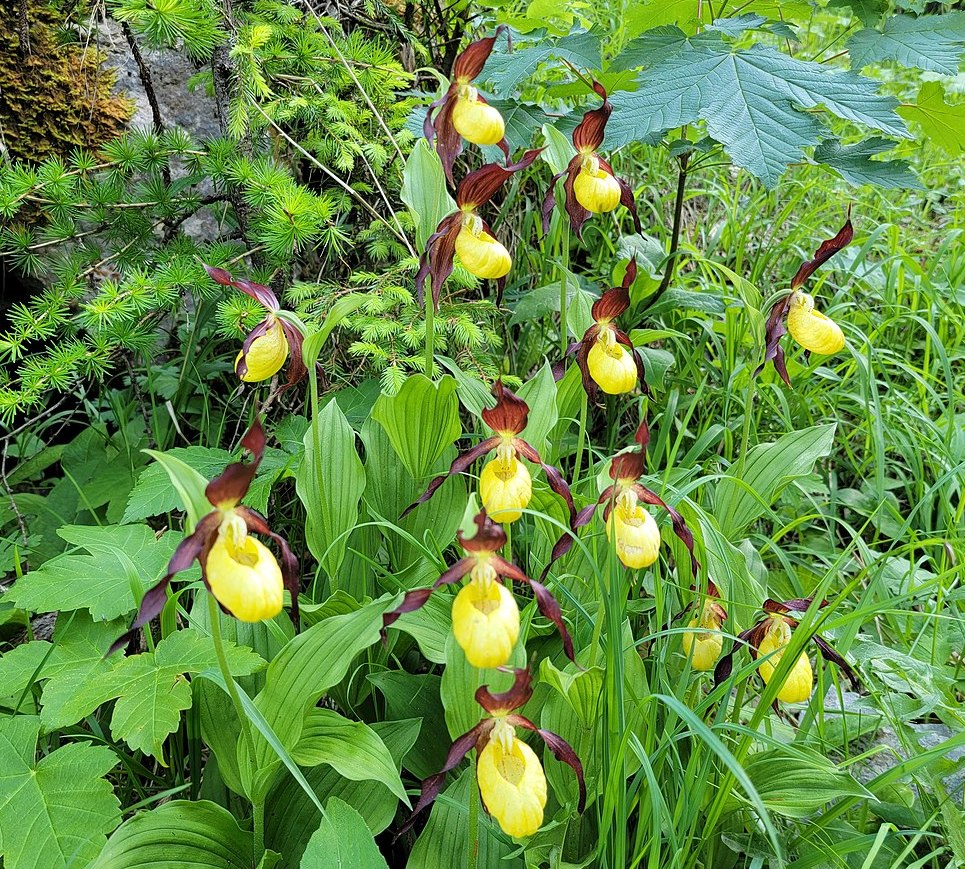
Close-up above by Johan N. in Wikipedia and Habitat picture by Allefant in Wikipedia.
Cyprepedium calceolus or Lady’s-slipper
According to Wikipedia this is the largest orchid species in Europe, growing to 60 cm tall with flowers as wide as 9 cm. Before it flowers, it is distinguished from other orchids by the large size and width of its ovate leaves (as big as 18 cm long, 9 cm wide), which like other orchids exhibit parallel venation.
This is a very rare orchid in the B.I. but it has a widespread distribution from Europe east through Asia from Spain to the Pacific, including almost every country in Europe plus Russia, northeastern China and Rebun Island in Japan.
It was formerly a reasonably widespread plant across northern England, particularly the limestone area of the Yorkshire Dales. By the late 20th century it had declined to just a single plant in one location in the dales.
While the virtual extinction of the lady’s-slipper orchid from its historical range in Britain is often blamed on uprooting by gardeners and botanists, it is also the case that its preferred habitat shrank markedly with human clearance of woodland from the limestone landscape, and the grazing of sheep will have finished it off.
It became a protected species in the UK in 1975 under the Conservation of Wild Creatures and Wild Plants Act. A reintroduction programme for the lady’s-slipper orchid is in place, and has led to a population of hundreds of plants as of 2003.
Ecology and Wildlife associates:
Cypripedium calceolus is frequently associated in stands of hazel.
It is pollinated by a number of different insect species, including at least seven species of miner bee in the genera Andrena and Colletes, as well as at least two species of Lasioglossum (furrow bees).
Plants are very vulnerable to herbivory by slugs and snails.
Garden Use and Cultivation tips:
With the help of Dutch plant breeder and wholesaler Anthura, the Genus and this species is commercially available in garden centers. Other laboratories and breeders have also developed the technique to mass-produce C. calceolus, so plants are commercially available, unlike many orchid species.
Tribe 2 NEOTTIEAE
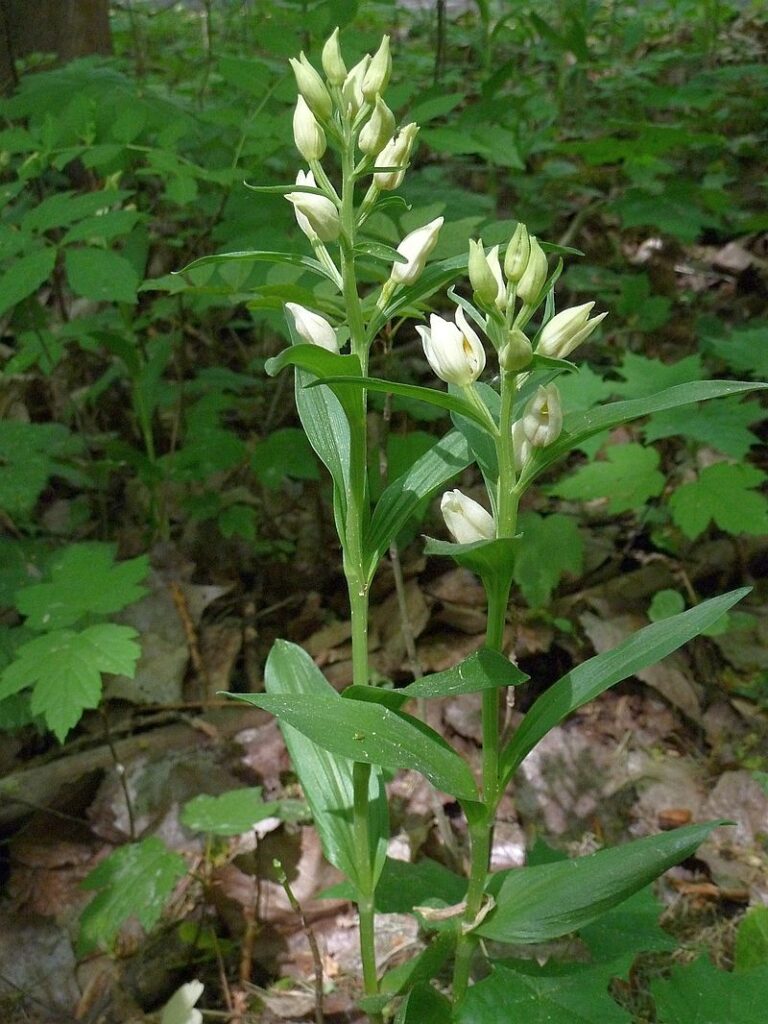
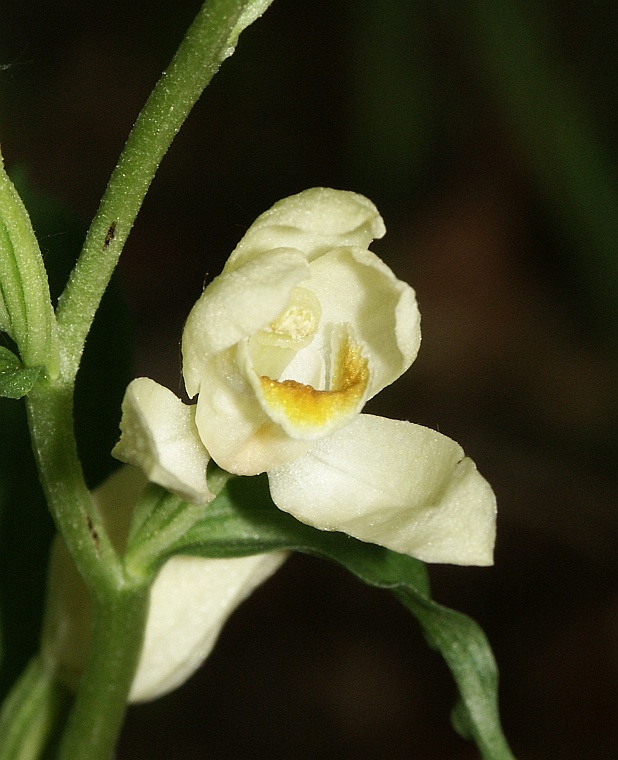
The White Helleborine plant above (by Joachim Lutz) and Close-up (Wikipedia)
A shade-loving rhizomatous perennial herb usually found in woods with little ground cover, especially those of Fagus, but also extending into chalk scrub. It is restricted to well-drained soils on chalk and oolitic limestone. It is usually self-pollinated and the flowers often fail to open entirely.
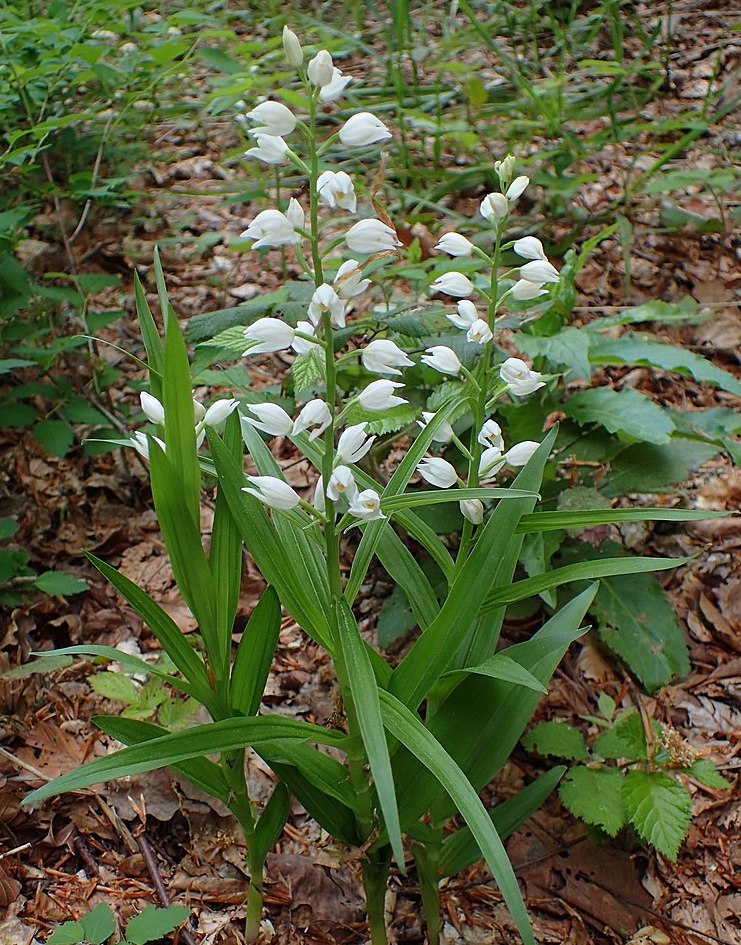
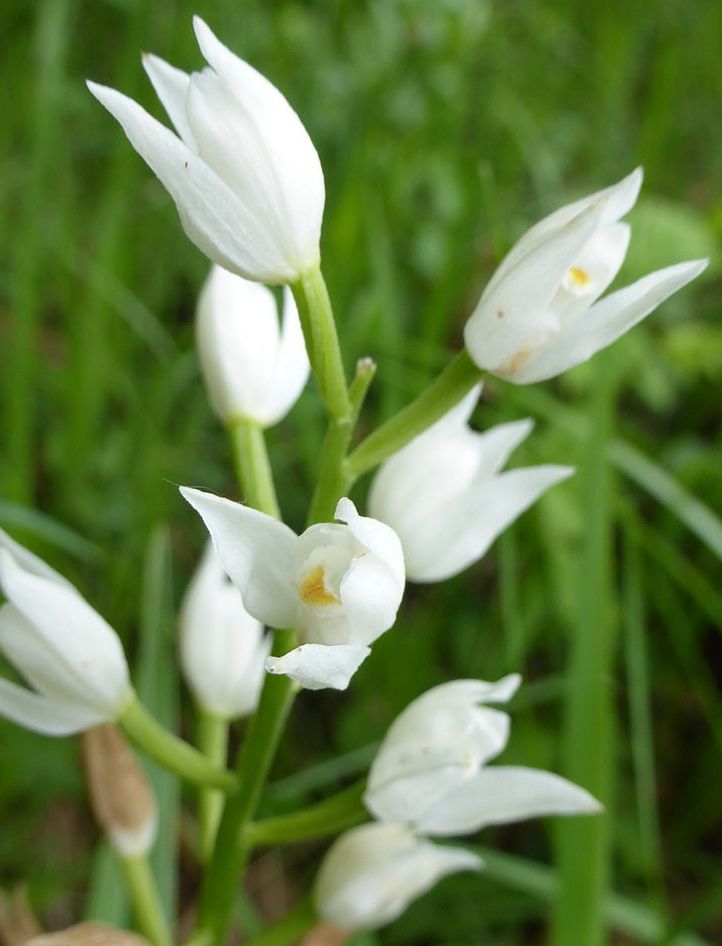
Narrow-leaved Helleborine plant above (by Krzysztof Ziarnek). Flower stem by By Joachim Lutz in Wikipedia.
- C. longifolia or Narrow-leaved Helleborine and see here
A rhizomatous perennial herb found in a variety of woodland types on calcareous soils, usually on chalk and hard limestone but also on calcareous schist in Scotland. It prefers permanent patches of light and is most frequent on steep, rocky slopes with an open tree canopy, but is also found along woodland edges and rides, and in scrub.
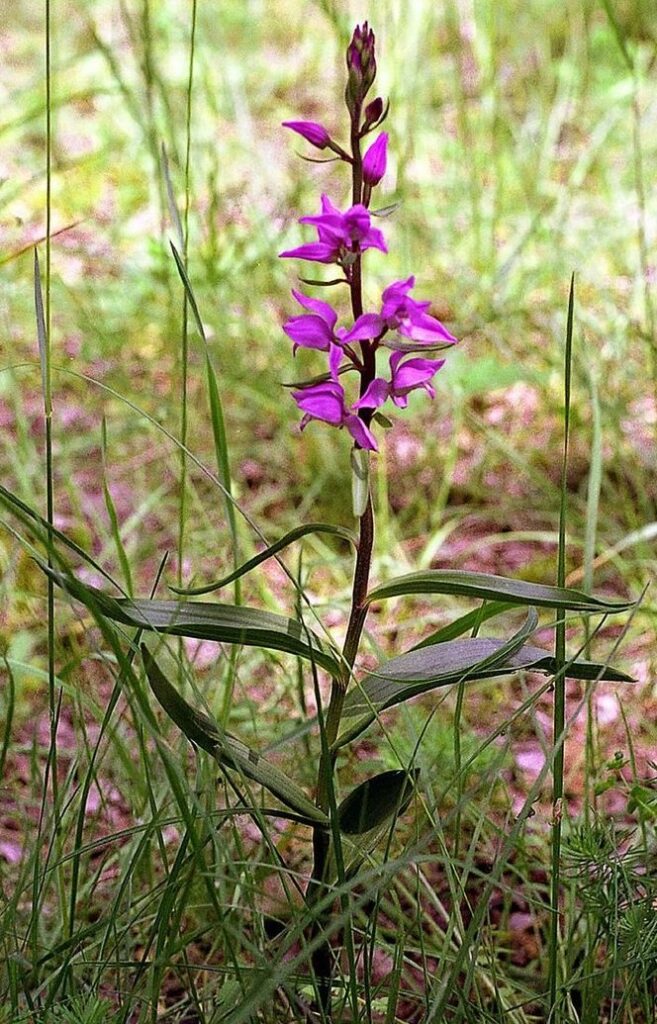
- C. rubra or Red Helleborine or here
A long-lived rhizomatous perennial herb of well-drained sloping sites in deciduous woods, particularly those of Fagus, on calcareous soils. It is a poor competitor and does not form large colonies. Flowers are rarely produced and seed-set is very low, possibly due to the rarity of suitable pollinators.
Ecology and Wildlife associates:
Cephalanthera rubra is thought to be mainly pollinated by flies, although often self-pollination is triggered by rainfall. Pollination may also be carried out by Chelostoma bee (Chelostoma campanularum?) and the weevil Miarus campanulae, both of which are thought to mistake the flowers for Campanula persicifolia, a wildflower found on mountains in continental Europe. It is theorised that C. rubra mimics C. persicifolia to increase pollination early in the year.
As the flowers are frequently visited by flies, crab spiders also have been observed hunting in them.
Epipactis spp or Helleborines (8 species and several hybrids):
The species occur in temperate and subtropical climates of America, Asia, and Europe. These orchids grow in open spaces in forests, in undergrowth, on calcareous soils and are often found in wet dune-slacks near the sea.
Most of these hardy orchids grow in a wet environment, but there are exceptions. The marsh helleborine (Epipactis palustris) is the only European orchid able to survive in a flooded habitat. However, Epipactis helleborine grows in more diverse habitats, from sheltered sandy beaches to open spaces in deciduous or coniferous forests, on roadsides, in meadows, and on moist soils.
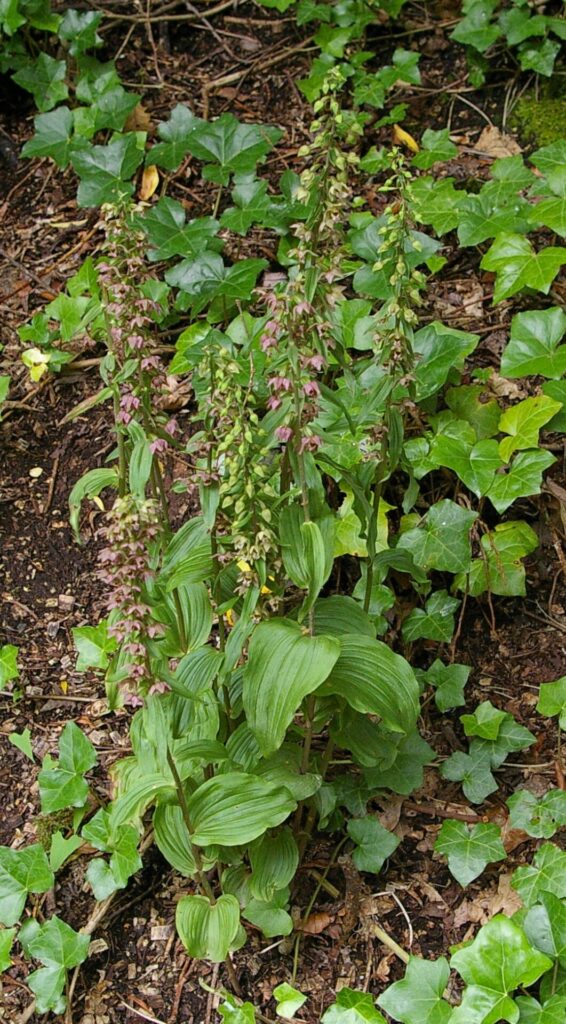
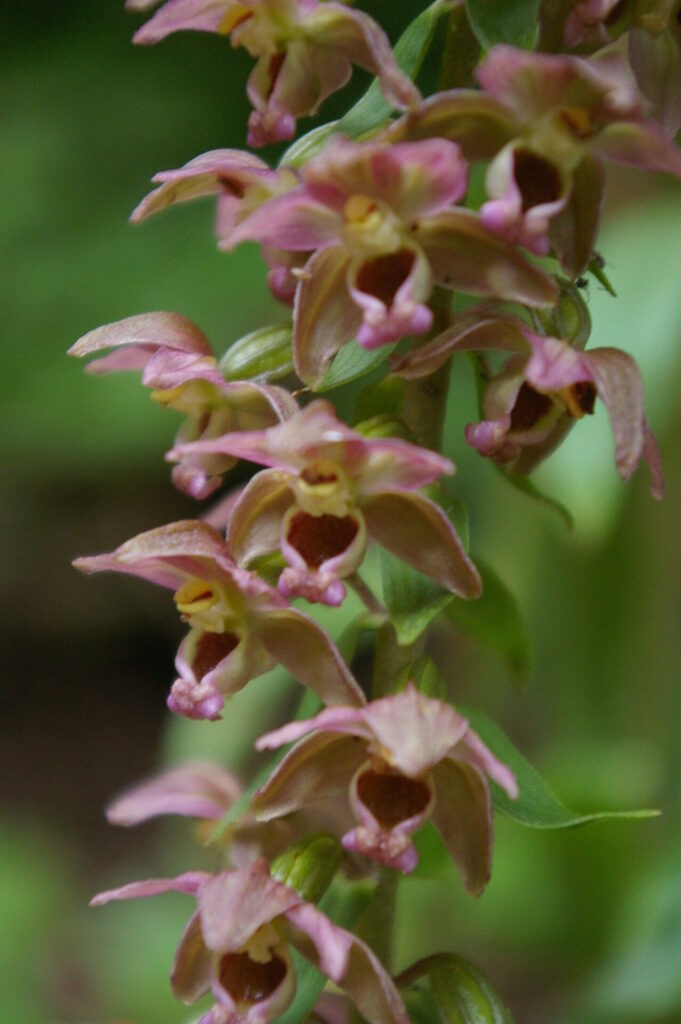
Broad-leaved Helleborine as found along the Worcester & Birmingham canal towpath, Selly Oak (Pictures by M.P.)
A rhizomatous perennial herb of calcareous to slightly acidic soils. Habitats include coniferous and deciduous woodland, hedgerows, shady banks, streamsides, roadsides, Alnus carr, dune-slacks, limestone pavement and screes. It may invade secondary woodland and also occurs in urban habitats, particularly abandoned gardens; it is said to be more common in Glasgow than anywhere else in Britain (Allan & Woods, 1993).
This species of orchid is pollinated by several species of Hymenoptera, particularly the common wasp, but also other species in the genera Vespula and Dolichovespula. Flowers release a sweet nectar to attract the wasps, which has an intoxicating effect on them. Eight populations of Epipactis helleborine in central Europe (Lower Silesia, Poland) had their nectar studied and they were found to contain naturally occurring oxycodone (as well as another narcotic-like opioid) in minute amounts.
- E. atrorubens or Dark-red Helleborine or see here
A perennial herb found mostly on bare rock or well-drained skeletal soils overlying limestone. Habitats include exposed scree slopes, open grassy banks, shaded grikes of limestone pavements and ledges on cliff and quarry faces. Reproduction is by seed but most populations are small and often include many non-flowering plants.
The flowers of this orchid species are often pollinated by insects, particularly bees.
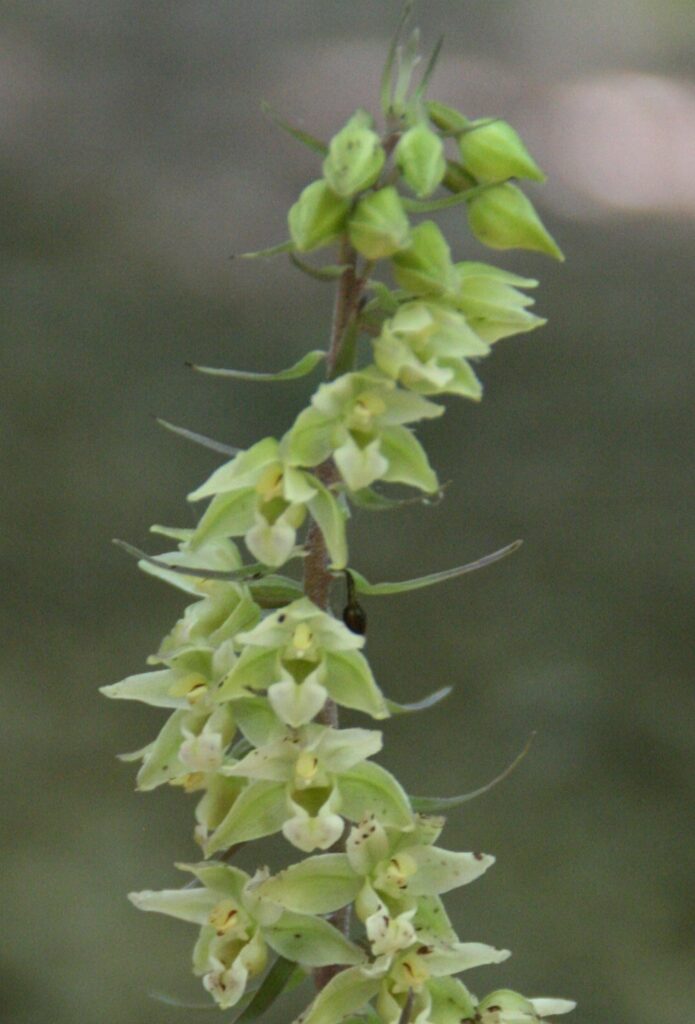
- E. purpurata or Violet Helleborine or see here for more pictures!
A perennial herb found in a range of woodland types. It is most frequent in densely shaded Fagus woods, particularly those on `clay-with-flints` deposits, but is also found on calcareous, and occasionally acidic, sands and clays in mixed woodland and coppices of Corylus and Carpinus.
- E. muelleri var muelleri (Syn. E. leptochila) or Narrow-lipped Helleborine or here
A rhizomatous perennial herb found in three distinct habitats: the deep shade of Fagus woods on calcareous substrates; under Betula on well-drained stony soils and spoil, often polluted with lead and zinc; and on the edges of dune-slacks where it grows amongst Salix repens and can spread into neighbouring conifer plantations.
A rhizomatous perennial herb typically found in sparsely vegetated, shaded places on dry, acidic, humus-poor substrates. Habitats include Fagus woods on flinty clays or sandstones, Pinus and Betula scrub on the Bagshot sands, Corylus coppice on sandy alluvium, and on sand dunes.
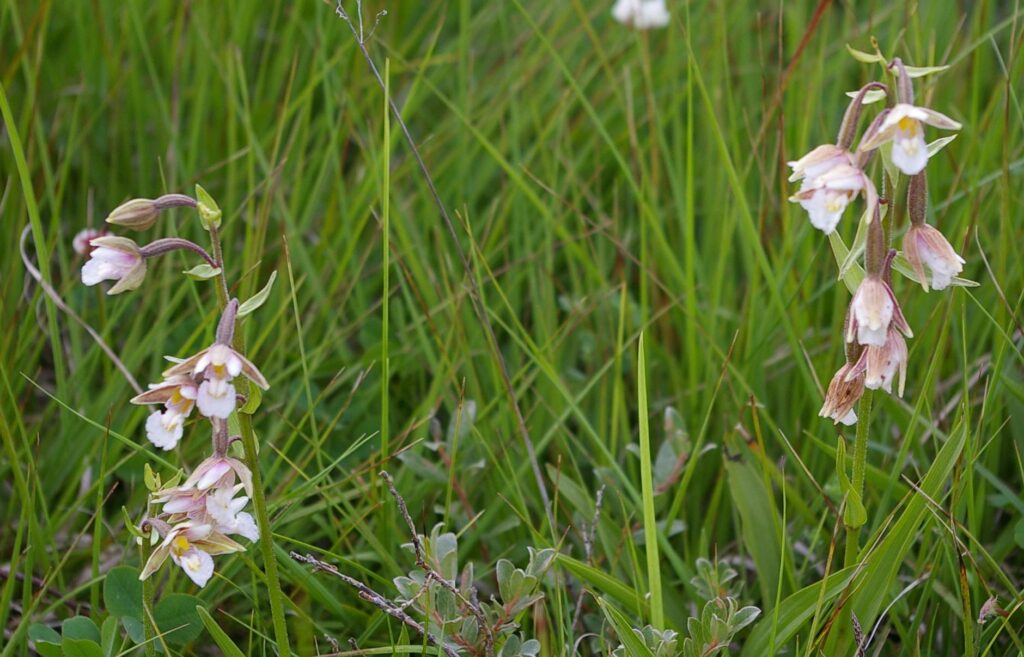
- E. palustris or Marsh Helleborine or see here
A rhizomatous perennial herb of neutral to calcareous fens, marshes, damp pastures, meadows and dune-slacks. It prefers flushed or seasonally inundated areas where competition from other vegetation is reduced. Other habitats include slumped terraces of wet, calcareous sea-cliffs and disused gravel-pits.
Flowers produce nectar and are pollinated by wasps, bees and Diptera.
E. youngiana or Young’s Helleborine or see here
A rhizomatous perennial herb originally found growing in an oak wood on clay soil, and on mildly acidic soils polluted with zinc and lead metals. It has since been found on the steep, lightly wooded slopes of coal-waste bings in Scotland. It is self-pollinated.
Neottia spp or Twayblades (3 species in Stace)
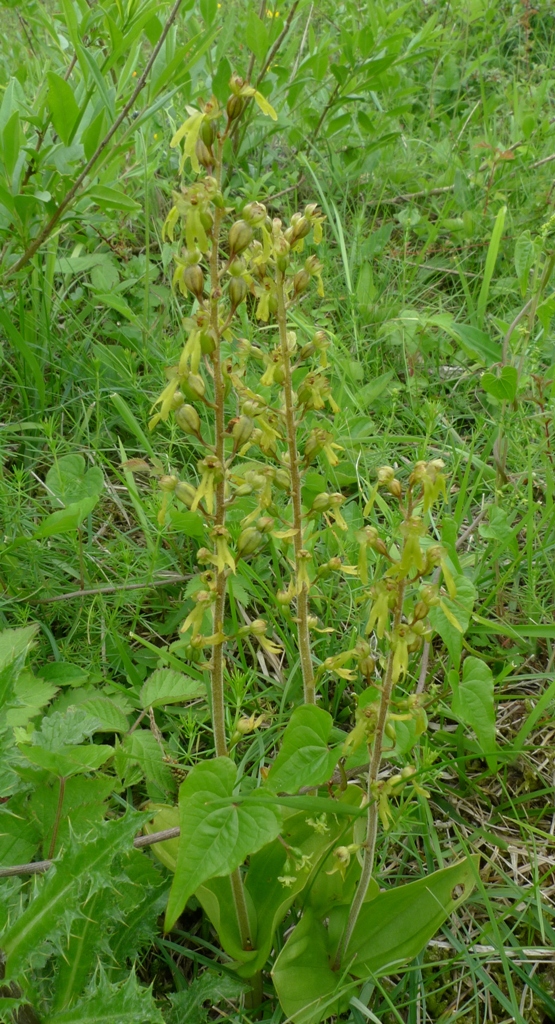
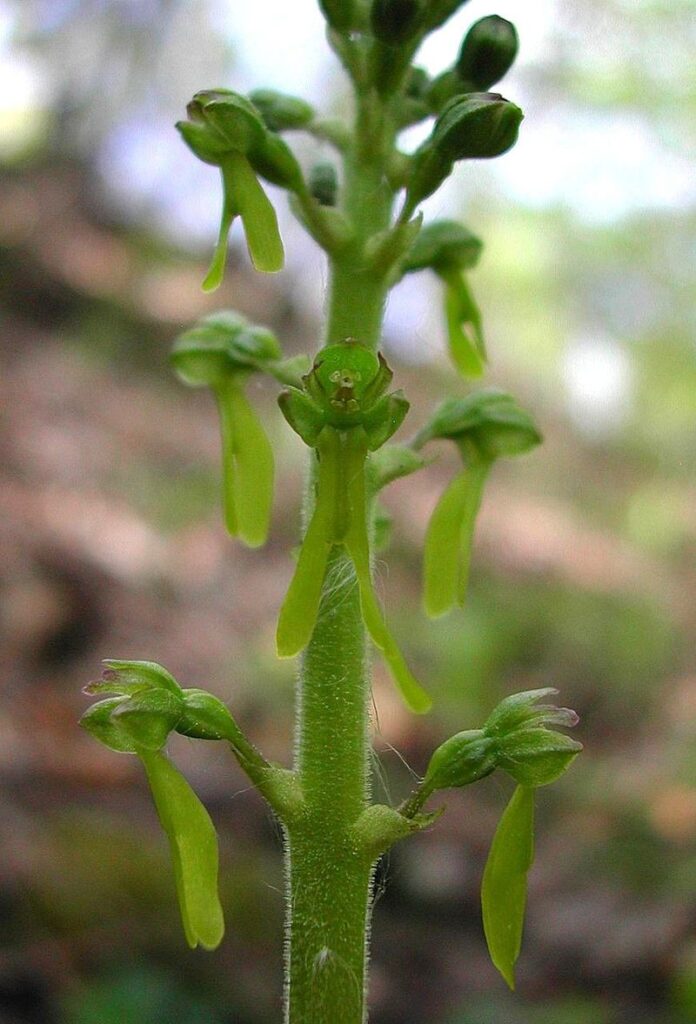
Common Twayblade (plant found at Harbury Spoilbanks SSSI (by M.P.), close-up (by Orchi)
- N. ovata (Syn. Listera ovata) or Common Twayblade
A rhizomatous perennial herb found on a wide range of calcareous to mildly acidic soils. Its habitats include grassland, woodland, hedgerows, scrub, sand dunes, dune-slacks, limestone pavement and heathland; in Anglesey and Ireland it also grows in fens. It frequently occurs, sometimes as large colonies, on railway embankments and in disused quarries and sand-pits.
The flower of Neottia ovata is well accessible for a wide range of insects. It is above all pollinated by parasitic wasps, sawflies and beetles. The pollinia lie free on top of the gutter-shaped rostellum, an organ that is filled with viscid fluid. When an insect touches the sensitive tip of the rostellum, the viscid fluid is ejected and glues the pollinia to the visitor’s body. Fruit set is quite high.
- N. cordata ( Syn. Listera cordata) or Lesser Twayblade
A perennial herb found in moorland and on peat bogs, often growing in Sphagnum or in the moss layer beneath Calluna and Vaccinium, always in wet, acidic conditions. It also grows in moss in damp, heavily shaded wood-carr, and occasionally under Pinus. Reproduction is by seed and root-buds.
The flowers produce nectar and are pollinated principally by fungus gnats in the groups Mycetophilidae and Sciaridae.
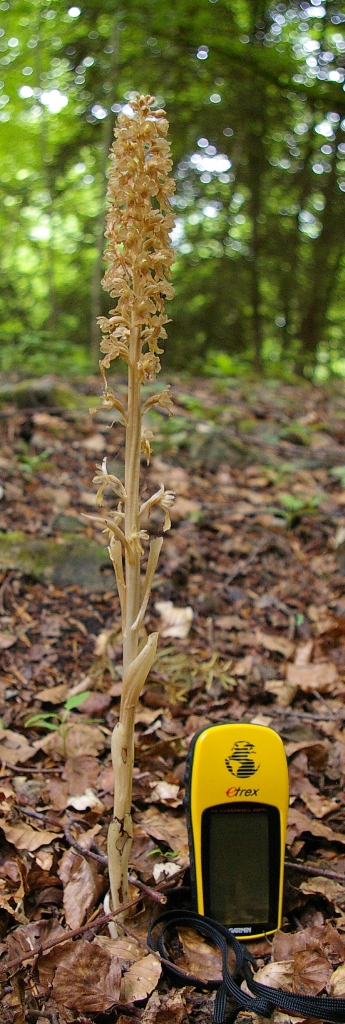
This saprophytic herb is most frequent in the deep humus of densely shaded Fagus woods on chalky soils. Less commonly it occurs in mixed deciduous woodland and mature Corylus coppices, on soils derived from limestones and base-rich clays and sands.
Pollination is carried out by Diptera and possibly also ants. Self-pollination may occur if insects do not pollinate the plants.
Tribe 3 GASTRODIEAE
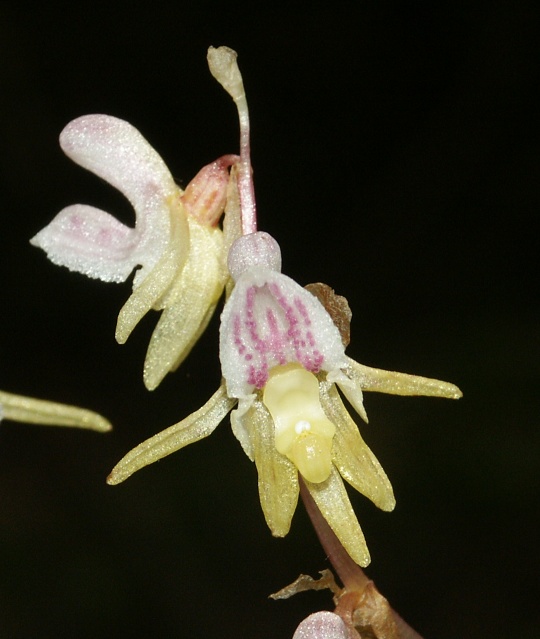
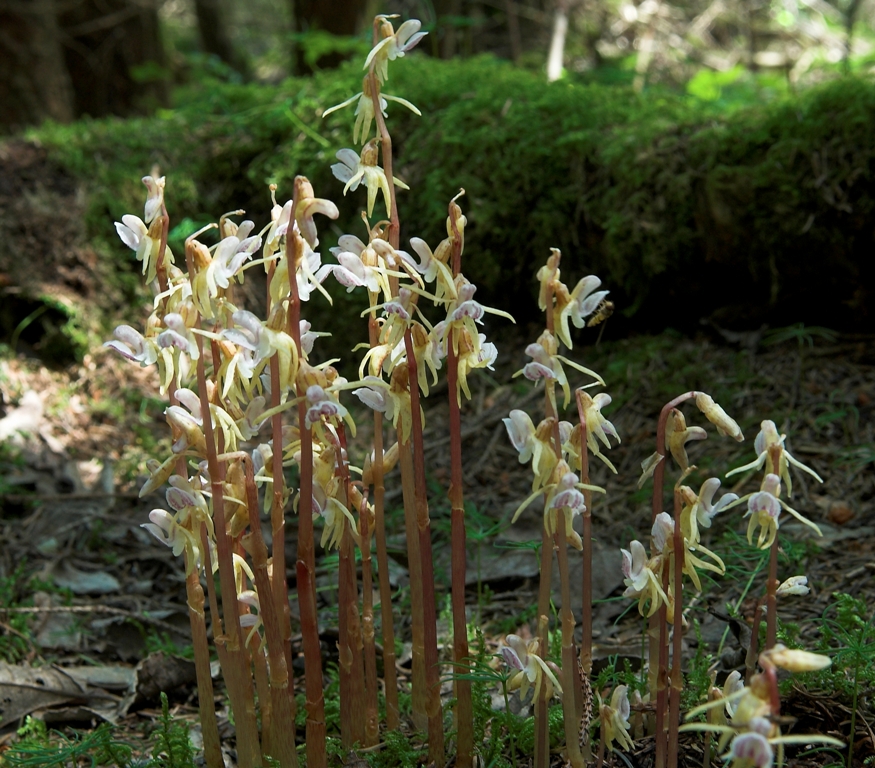
The rare Ghost Orchid (close up) and habitat by Hans Stieglitz in Wikipedia)
Epipogium aphyllum or Ghost Orchid or see here
This is as the Common Name suggest very elusive!
A saprophytic herb usually growing in deep leaf-litter in Fagus woods on chalk, with little or no associated ground flora. It is also occasionally recorded from Quercus woodland. The underground rhizomes have considerable longevity but the stems are short-lived and may not be produced annually. Although its flowers are pollinated by bees, seed is rarely produced.
Once thought to be saprophytic, these hardy plants are actually obligate mycoheterotrophs (or epiparasites) that obtain nutrients from mycorrhizal networks involving basidiomycete fungi that are in turn associated with the roots of various species of coniferous trees. They grow from an underground, burrowing stem which lacks chlorophyll and possesses ephemeral leaves that are small scales. The plants only emerge above ground to flower, especially during very wet summers in Western Europe.
Tribe 4 MALAXIDEAE
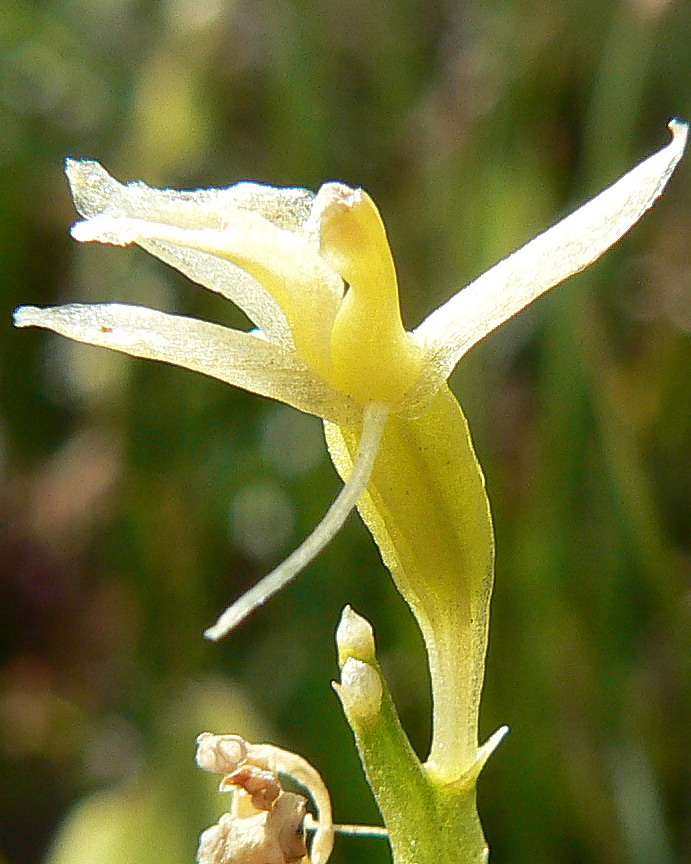
In East Anglia this pseudobulbous perennial herb is restricted to species-rich fens on infertile soils, and to old peat cuttings. Elsewhere, it grows in young dune-slacks.
Also see info from Plantlife here.
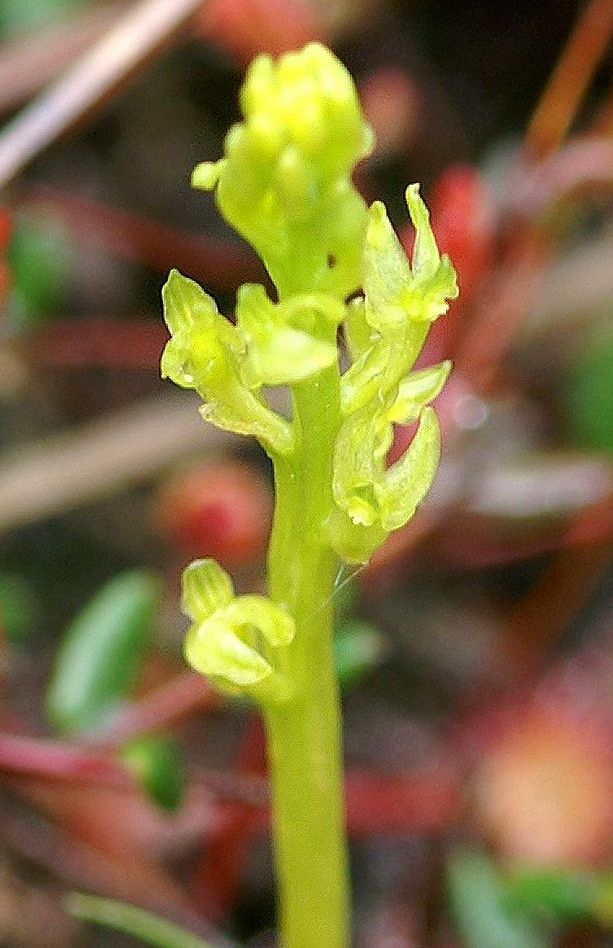
Hammarbya paludosa or Bog Orchid
A pseudobulbous herb of boggy areas where the water is usually acidic but subject to some lateral movement. Typically it grows amongst saturated Sphagnum, but also on peaty mud and among grasses on the edges of runnels and flushes.
The flowers are pollinated by small flies. The plant reproduces with seeds or by means of bulbils, small buds which drop off and develop into new plants. The orchid has no true roots and is dependent on fungi in its rhizome to obtain nutrients. The bulbils do not carry fungi from the mother plant and must be infected by the fungi of the right species in the soil in order to develop into a new plant. The rhizome grows vertically in the soil and each year a new pseudobulb develops at the top.
Tribe 5 CALYPSOEAE
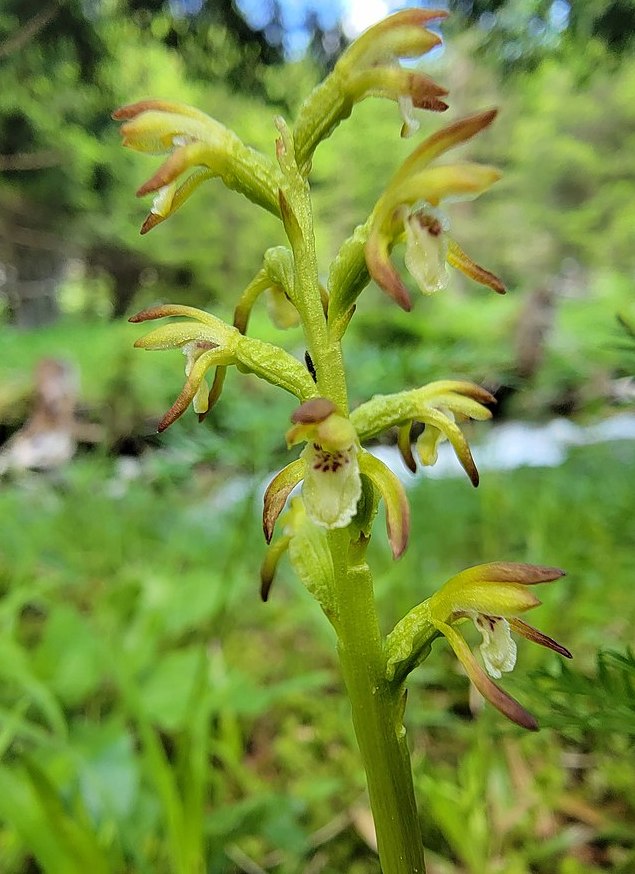
Corallorhiza trifida or Coralroot Orchid or see here
A saprophytic herb usually found in shaded, damp, Alnus and Salix carr on raised mires and lake margins, but which also occurs in dune-slacks with Salix repens. More rarely, it grows in tall-herb fen, in Betula and Pinus woods (amongst Sphagnum) and on moorland. It may colonise secondary habitats, including plantations and quarries.
Despite being able to produce some chlorophyll (hence some plants are greenish, although many are purple-brown), this orchid is largely saprophytic, depending mainly for its food on the mycorrhizal fungi surrounding its roots. Coralroot is usually self-pollinating.
Tribe 6 CRANICHIDEAE
Spiranthes spp. (3 spp in Stace)
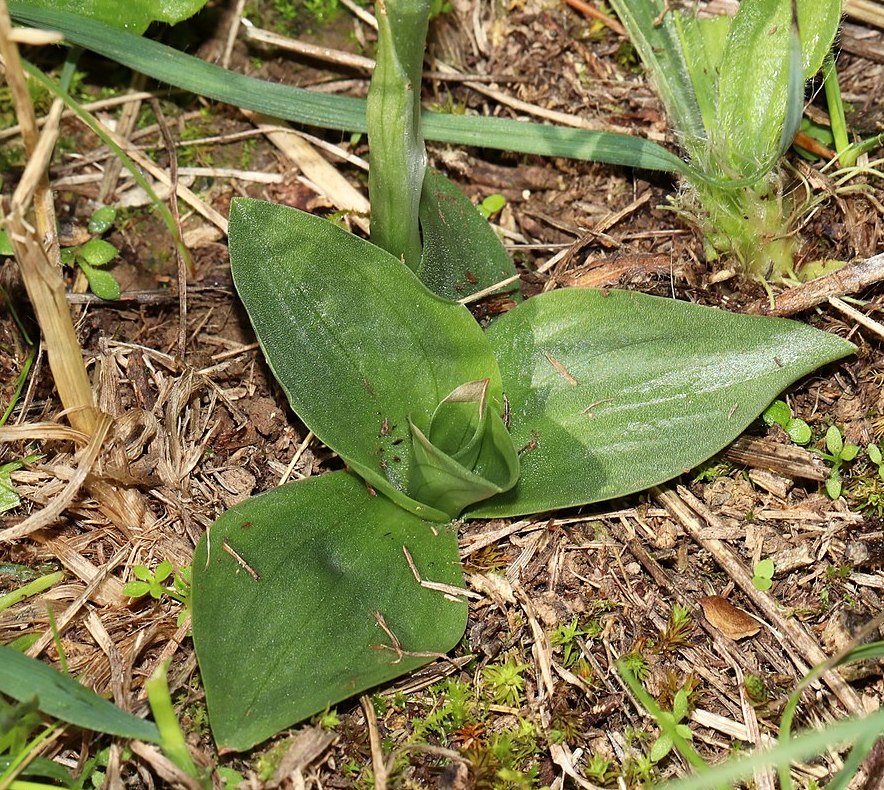
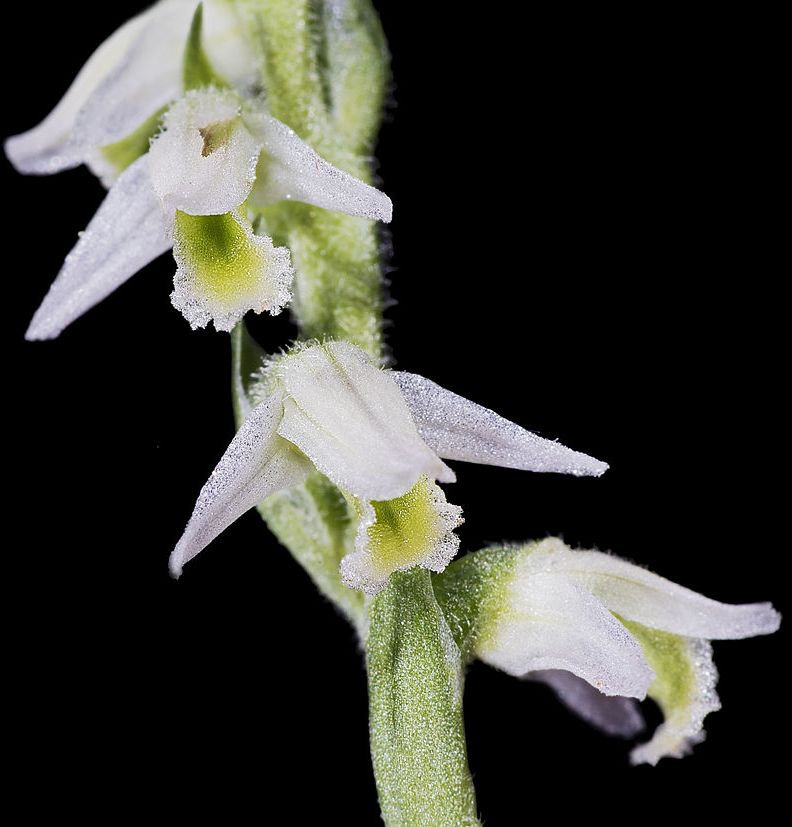
Autumn Lady’s-tresses leaf rosette (by Umberto Ferrando). Flowers by Didier Descouens.
Spiranthes spiralis or Autumn Lady’s-tresses and info Hardy Orchid Society.
A rhizomatous herb of unimproved, well-grazed grassland on dry calcareous soils, especially on chalk and limestone, and on cliff-tops and sand dunes; also on lawns and, rarely, on less acidic heathland. It can persist for many years without flowering, appearing in hundreds when grazing or mowing ceases.
The pollinators land on the lower lip. On the rear part of the lip are two glands that secrete nectar which is collected in small cavities immediately below them. The access to the nectar is very narrow to by the protruding edge of the column and the glands, and will cause the tongue of the bumblebee or bee to tear a membrane that covers the base of the two pollinia. As a result, the bees tongue comes into contact with an adhesive which hardens directly when exposed to the air. When the tongue is retracted the pollinia cling to it. The lip of flowers that is a few day more matured has opened further making access to the nectar gland wider and making the tongue brush past the stigma and deliver the pollen. Such a flower which develops first to release the pollen, and is later adapted to be pollinated is called protandrous.
In 52% of the plants the flowers are arranged counterclockwise, in 39% clockwise and in 9% of the plants the flowers are to one side of the inflorescence. The pollinators always land at bottom of the inflorescence and visit the flowers ever higher up. Most bumblebees have a strong preference for counterclockwise arrangement, fewer for clockwise. It seems that autumn lady’s tresses responds to this preference by offering different inflorescence types and thus increases the chances of fertilization.
S. romanzoffiana or Irish Lady’s-tresses
A rhizomatous herb of acidic, nutrient poor, periodically flooded or flushed vegetation, often growing on peaty soils by rivers, streams and lake margins. It frequently occurs amongst Molinia caerulea in pastures grazed by cattle or ponies. Reproduction is mostly vegetative in our area.
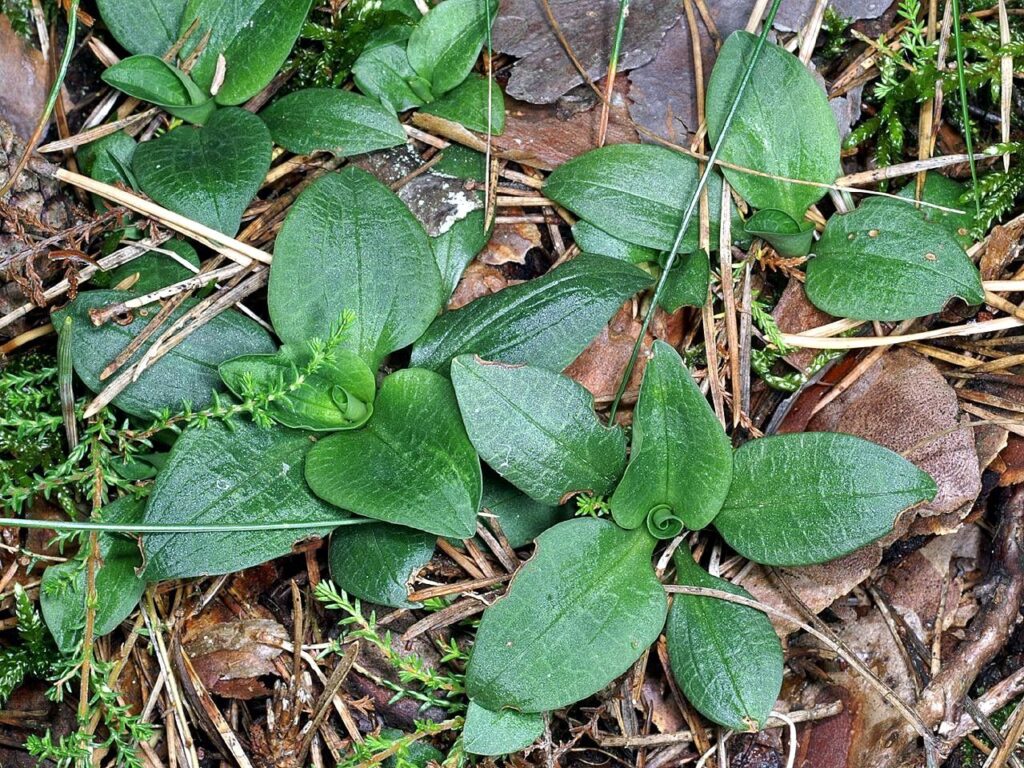
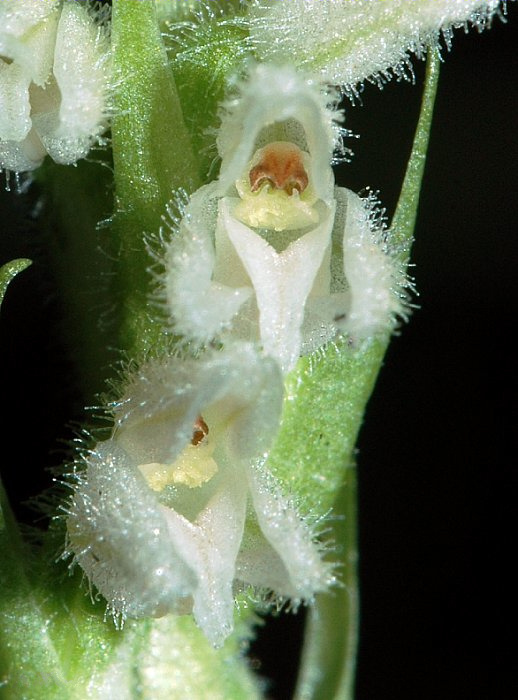
Creeping Lady’s-tresses rosettes by Orchi and flower close-up by Mg-k in Wikipedia.
Goodyera repens or Creeping Lady’s-tresses and here
A creeping, evergreen perennial herb of semi-natural and planted coniferous woodland, usually of Pinus sylvestris, where it grows in slight to moderate shade in moist layers of moss and pine-needles. It is also found under Pinus on old sand dunes.
This orchid is pollinated by bumblebees, allowing for its sexual reproduction. It can also reproduce vegetatively.
Tribe 7 ORCHIDEAE
This is the most common tribe in the BI with 11 genera mentioned in Stace. It is also complex with many intergeneric crosses.
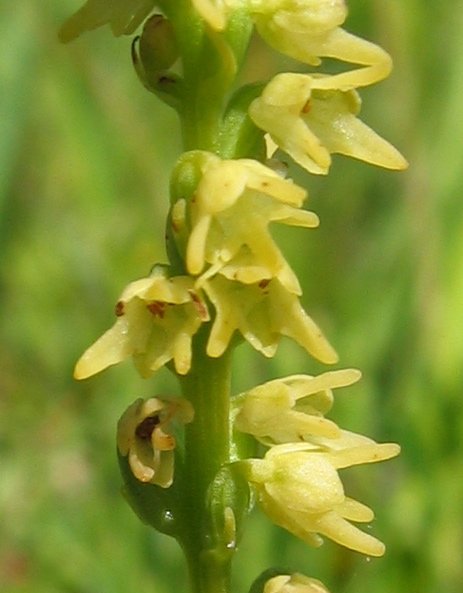
Hermenium monorchis or Musk Orchid
A tuberous perennial herb of short turf on calcareous soils overlying chalk or oolitic limestone, particularly on the small terracettes of steep slopes. It also grows on quarry floors and on old lime kiln spoil heaps.
Plathanthera spp or Butterfly-Orchids
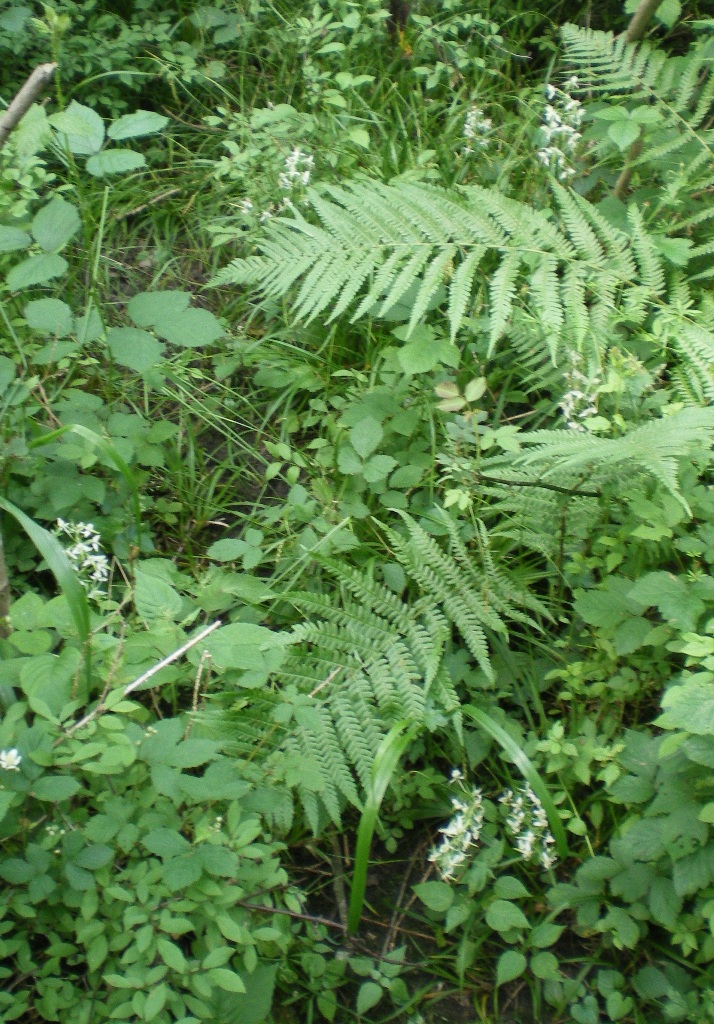
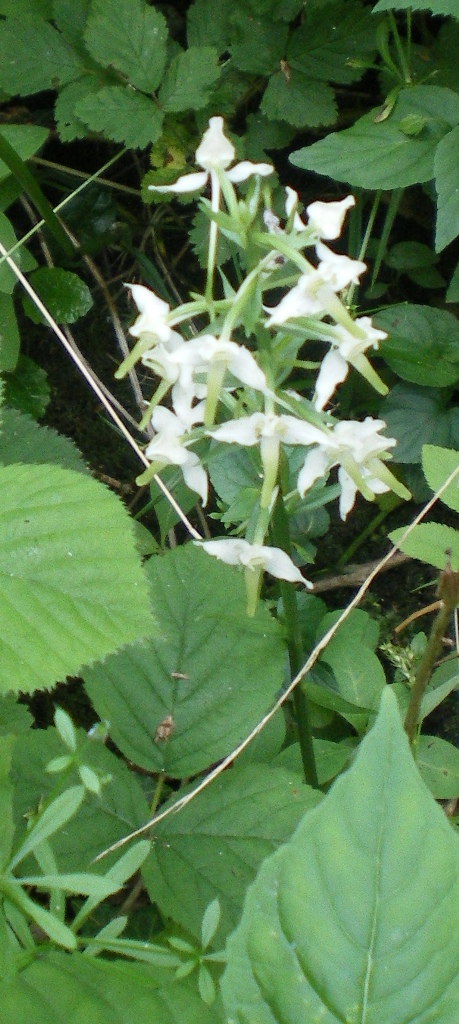
Greater Butterfly-orchid (both pictures by Andrew Bennett)
- P. chlorantha or Greater Butterfly-orchid or see here
This perennial herb is found in a wide variety of habitats, usually on well-drained calcareous soils. Typical habitats include downland, rough pasture, hay meadows, scrub, woodland and young plantations. It sometimes occurs on sand dunes and railway embankments. Rarely, it grows on slightly acidic soils in moorland and wet, heathy pasture.
Flower
Greater butterfly-orchid is similar to lesser butterfly-orchid, Platanthera bifolia, which is about the same size, but with smaller flowers. Greater butterfly-orchid is a herbaceous perennial of medium height. Its leaves are broad, shiny and elliptical, with a large pair at the base, and much smaller, more lanceolate leaves up the stem. The flowers are greenish-white, scented of vanilla, with spreading sepals and petals. The lip of the flower is long, narrow and undivided. The flower has a very long spur. The flowers form a rather loose spike. The pollen masses diverge to touch both sides of the pollinating insect
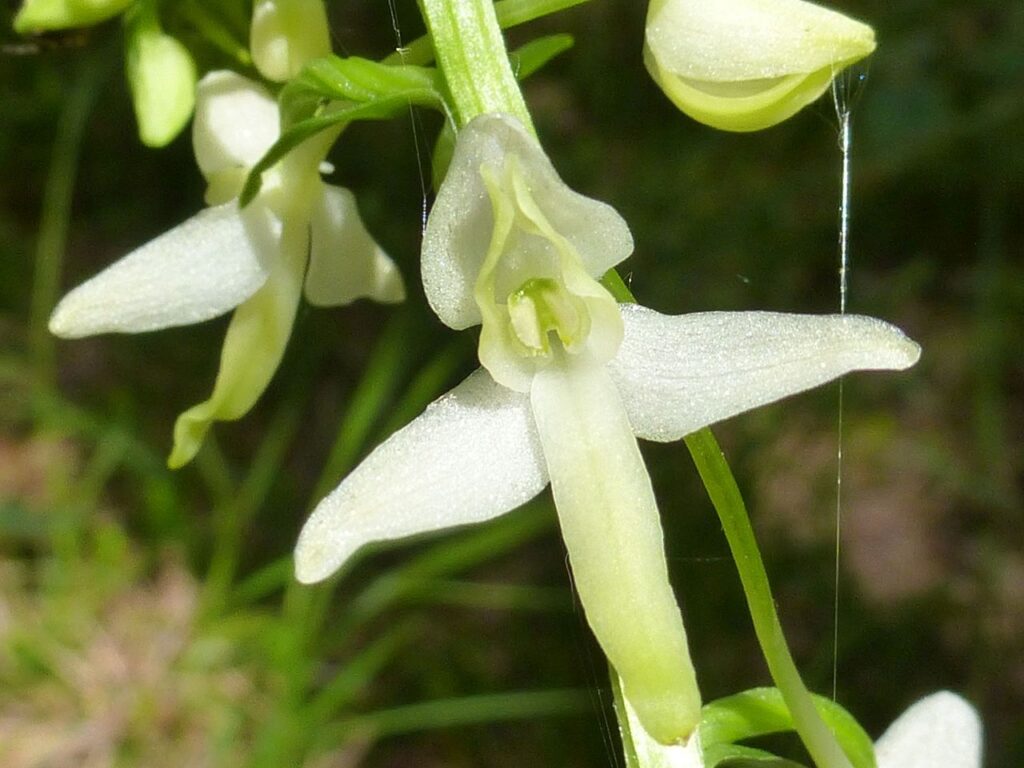
- P. bifolia or Lesser Butterfly-orchid or see here
A perennial herb of heathy pastures, grassland, open scrub, woodland edges and rides, and on moorland, often amongst Pteridium; it is found on a wide variety of acidic and calcareous soils overlying sands, gravels and clays. It is tolerant of considerable soil moisture, also being found in acidic bogs and calcareous fens.
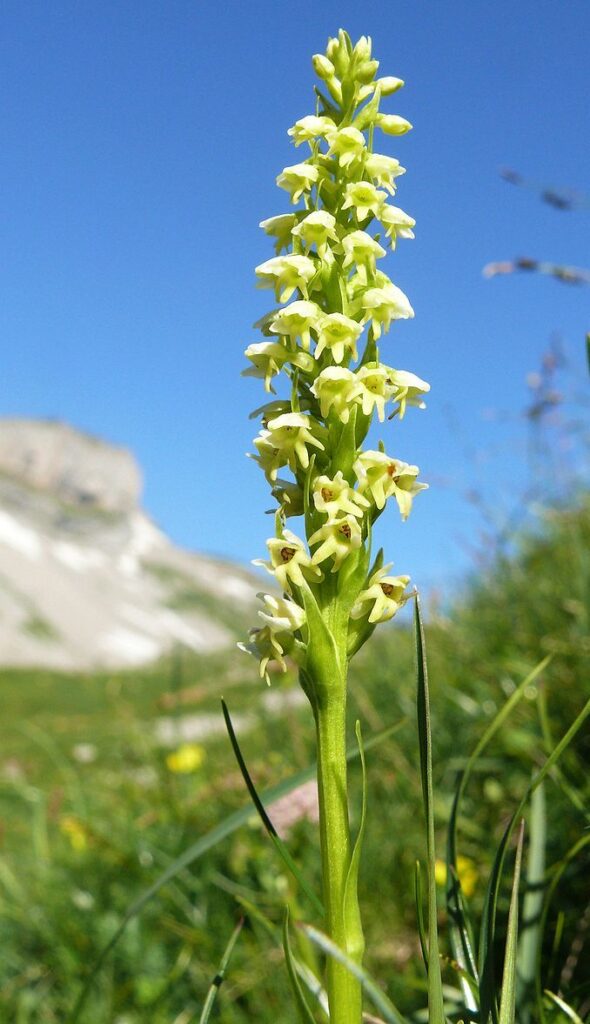
Pseudoorchis albida or Small-white orchid or here
A tuberous perennial herb of well-drained hill pastures, streamsides, mountain grasslands and cliff ledges on a range of dry, acidic or calcareous soils; also on recently burnt moorland, but not persisting when Calluna regrows. Rarely, it occurs in acidic Quercus woodland.
Gymnadenia spp or Fragrant orchids
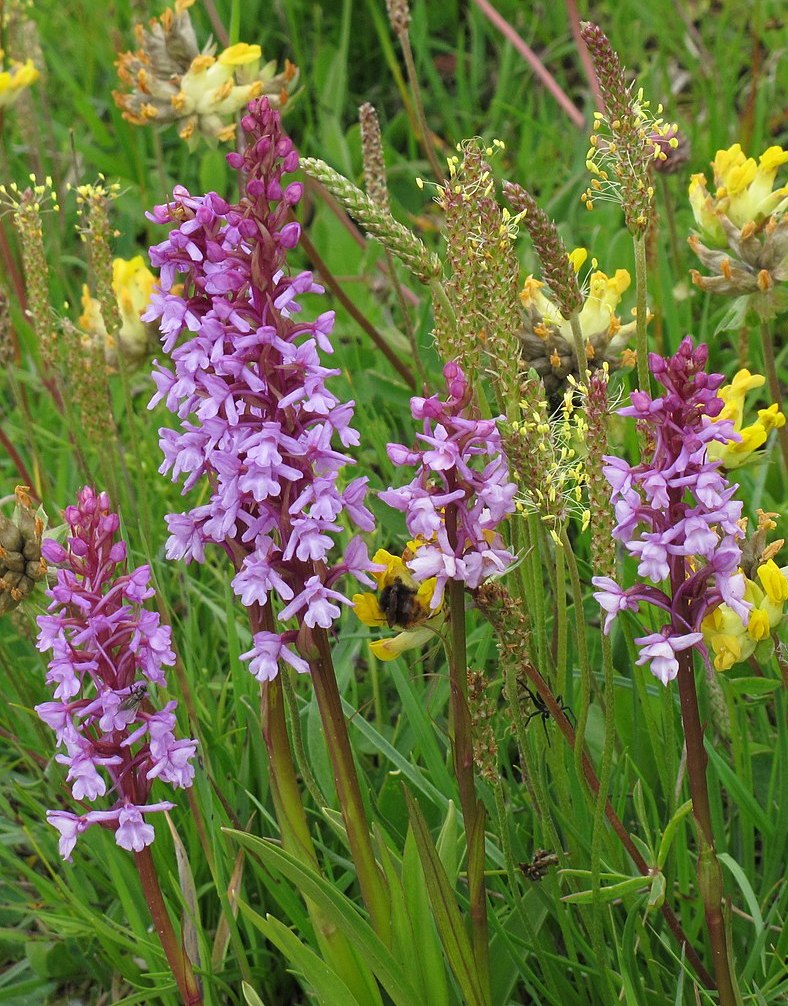
- G. conopsea or Fragrant Orchid or see here
A tuberous perennial herb of both dry and moist chalk and limestone grasslands, limestone pavement, less acidic heaths, and wetter habitats such as base-rich fens. It also grows in artificial habitats, including quarries and railway banks.
The species is almost exclusively pollinated by moths (Lepidoptera). The most common pollinators are the small elephant hawk-moth (Deilephila porcellus), hummingbird hawk-moth (Macroglossum stellatarum), silver Y (Autographa gamma), burnished brass (Diachrysia chrysitis) and large yellow underwing (Noctua pronuba). Fruit set is high with an average of 73%.
A tuberous perennial herb characteristically found in base-rich wet meadows, fens and ditches. Occasionally it is recorded from N.-facing chalk and limestone grassland. It sometimes grows with G. conopsea subsp. borealis and is the most common subspecies in Ireland.
Dactylorhiza or Marsh-orchids (Stace mentions 8 spp as well as many ssp & hybrids!)
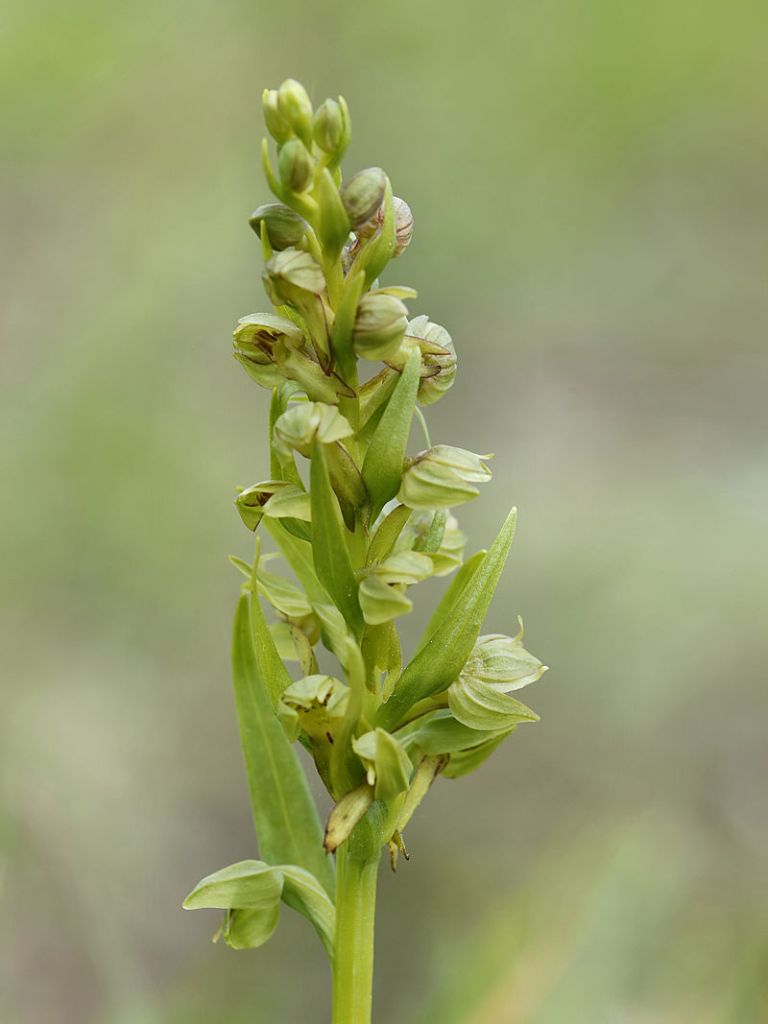
Dactylorhiza viridis (syn. Coeloglossum viride) or Frog Orchid
A tuberous perennial herb restricted in S. Britain to dry, well-grazed, base-rich grassland such as chalk downland and dunes, and in chalk-pits. Elsewhere it grows in a wider range of calcareous grasslands, flushes, limestone pavement, scree, rocky ledges, roadsides and quarries.
It is either pollinated by bees and small wasps, or reproduces autogamously by incoherent pollinia; that is, the pollinia crumble and some pollen falls on the stigma, fertilizing the flower.
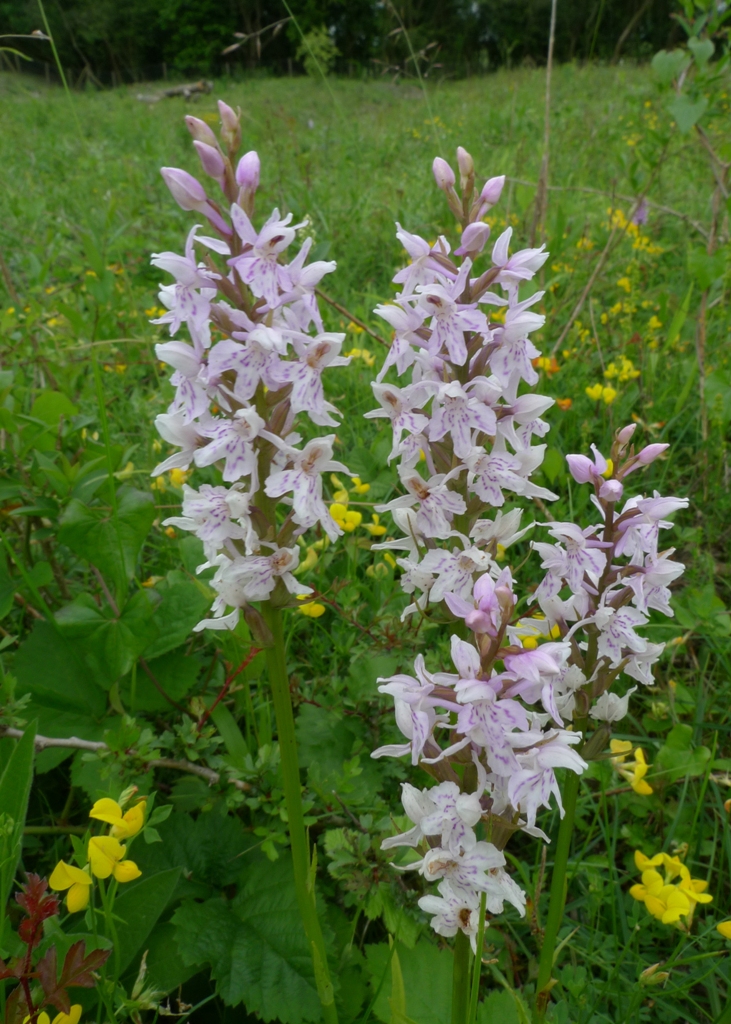
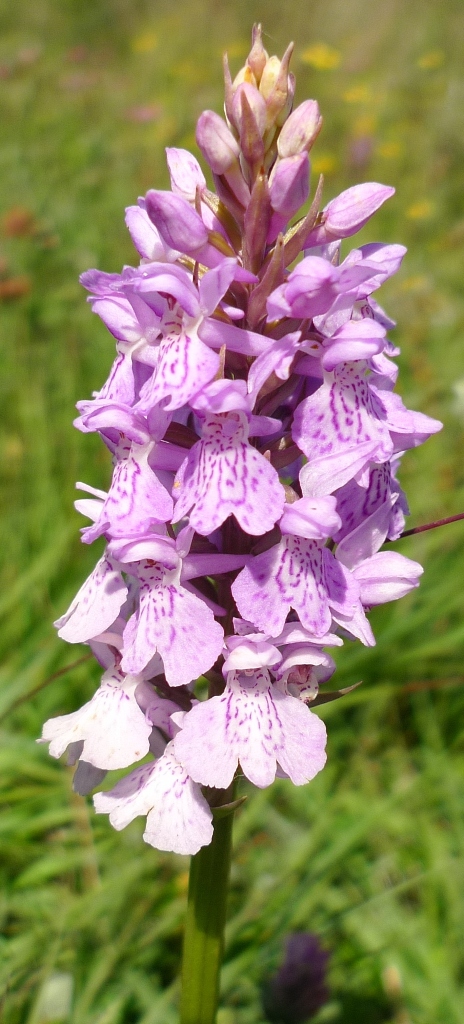
4 different examples of Common Spotted-orchid (by Mike Poulton)
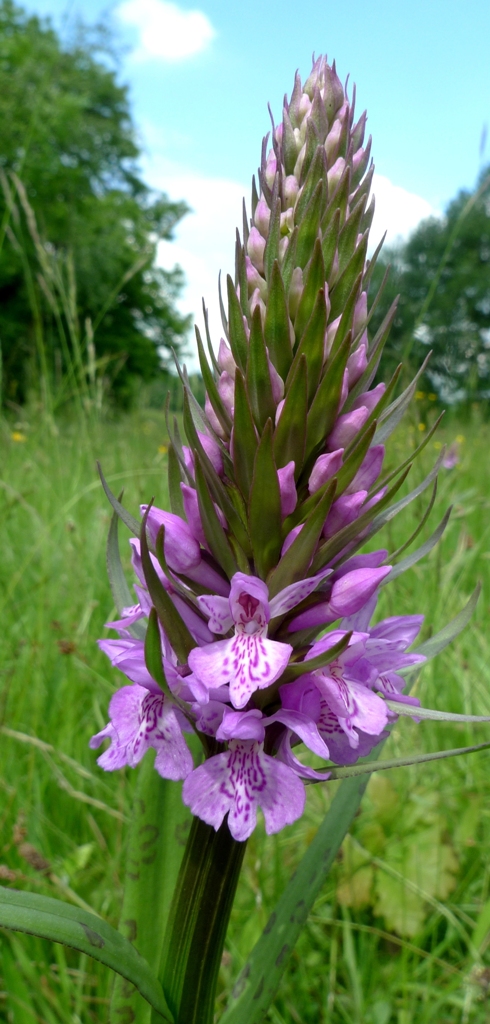
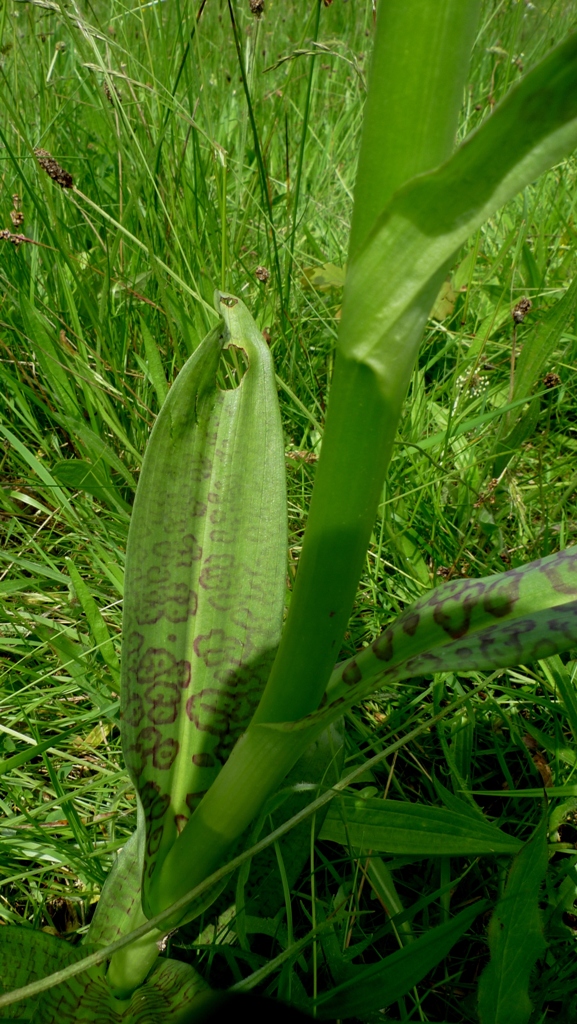
This tuberous perennial herb grows on neutral or base-rich soils in a wide range of habitats, including deciduous woodland, scrub, roadsides, chalk grassland, meadows, marshes, dune-slacks, fens and mildly acidic heaths. It can become abundant in artificial habitats such as waste ground, abandoned gravel-pits, quarries and railway embankments.
Pollination may be by bumblebees, or the longhorn beetle Alosterna tabacicolor.
A tuberous perennial herb commonly found where the parents grow together, typically in habitats such as marshes, fens and wet meadows, but also on dry chalk downland. It is especially frequent in man-made habitats such as quarries and industrial waste land, and may persist in the absence of D. praetermissa if drainage has caused the loss of this species from the site. This hybrid is triploid, partially fertile and frequently back-crosses with the parents, creating long-lived hybrid swarms.
This tuberous perennial herb is found on a range of well-drained or wet acidic soils in a wide variety of habitats, including grasslands, moors, heaths, flushes and bogs. It also occurs in pockets of peat on limestone and, more rarely, in open woodland
Dactylorhiza maculata is pollinated by insects, especially bumblebees. The flowers are ‘food deceptive’, i.e. do not provide nectar for their pollinators.
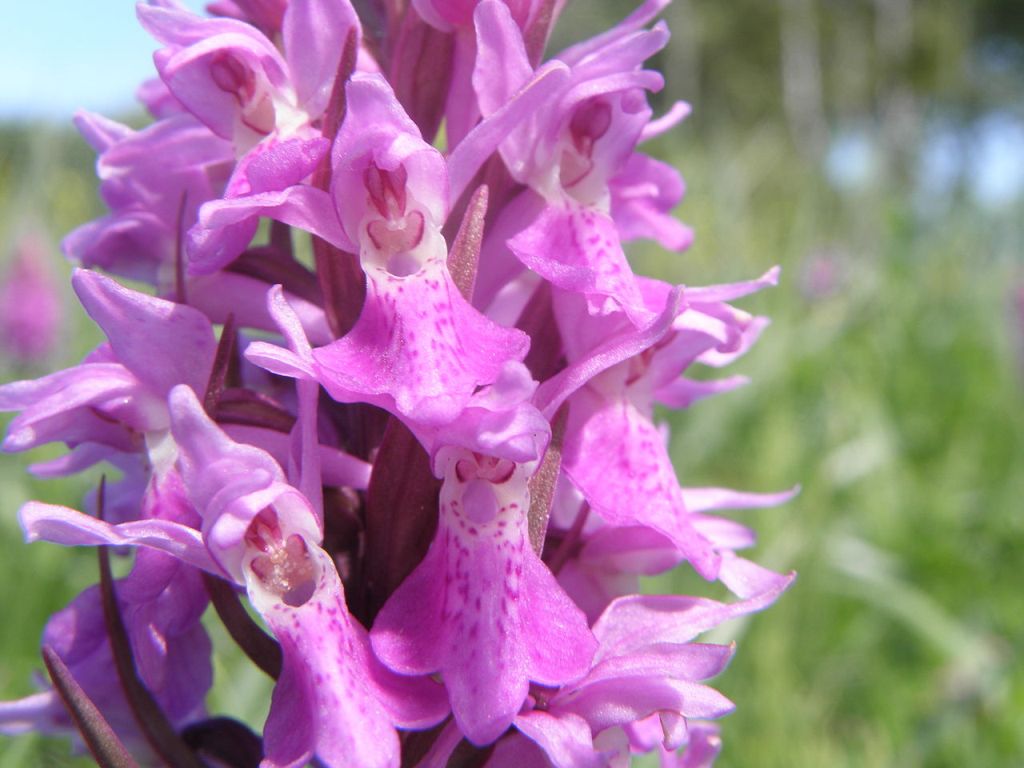
A tuberous perennial herb of calcareous marshes, fens, damp meadows, roadsides and dune-slacks, and also less acidic bogs and wet heathland. It avoids areas that are inundated for long periods, and is rarely found in drier sites such as chalk downland. It also colonises artificial habitats such as quarries and industrial waste ground.
The flowers of this species are pollinated by insects including the cuckoo bee and skipper butterfly
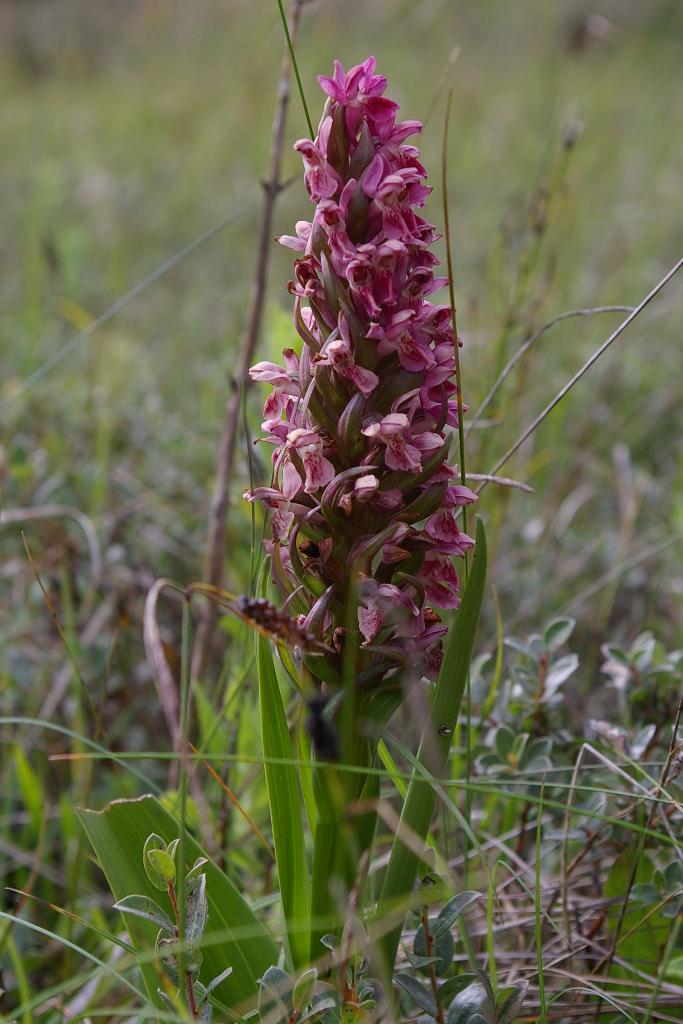
A tuberous perennial herb growing on damp or wet calcareous soils, in meadows, marshes, ditches, fens, flushes and dune-slacks, and also on more acidic soils in bogs and damp heaths.
See for list of subspecies here
A tuberous perennial herb of neutral to base-rich soils, occurring in dune-slacks, fens, marshes, wet meadows, flushes, ditches and on roadside verges. It is also frequent in old quarries and urban waste land, where it can colonise drier sites such as rubble, and it occasionally grows in neglected gardens.
A tuberous perennial herb of damp, base-rich habitats such as marshes, water-meadows, flushes and fens. It sometimes prefers more open flushed or very wet areas with reduced competition.
A tuberous perennial herb of damp, calcareous soils, growing in fens, marshes, wet meadows and dune-slacks.
Subspecies & varieties and Conservation:
As with many marsh plants, the numbers of this species have been dwindling for quite some time. The main causes are the entry of nitrogen via fertilizer, drying out of the habitat, and intensive conversion to pasture. The broad-leaved marsh orchid does not react so sensitively to changes in its habitat as for example the early marsh orchid, Dactylorhiza incarnata. It is usually the last of the native orchids to disappear. This tolerance makes it a still relatively common species.
Orchis spp or orchids
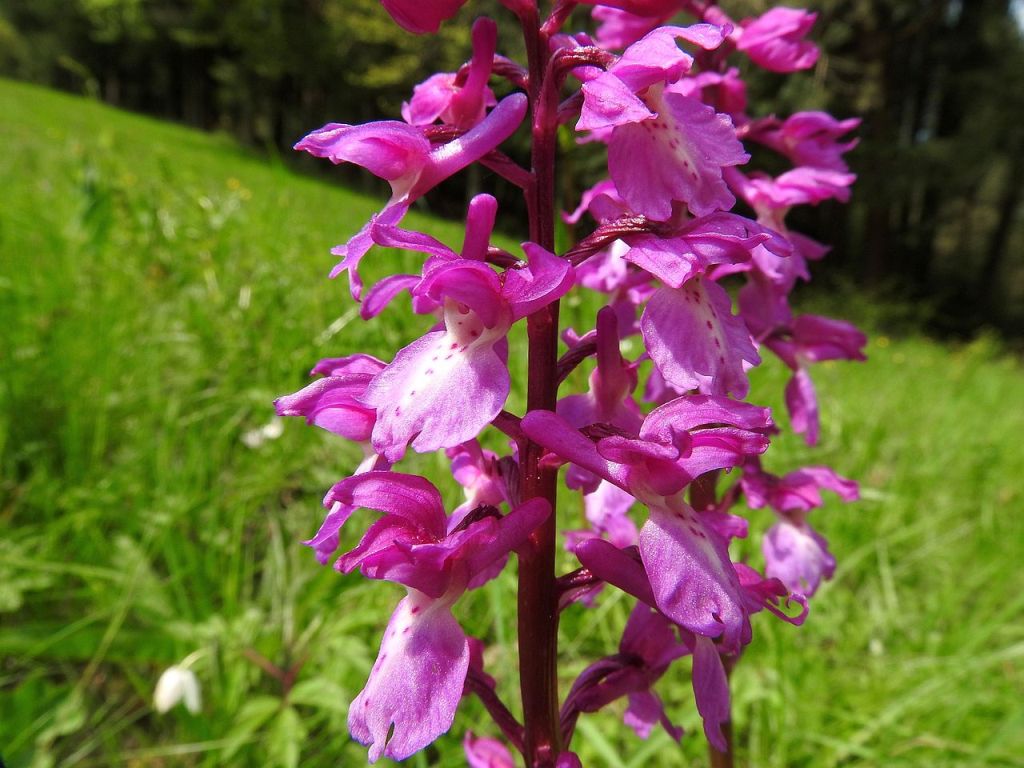
This tuberous perennial herb grows on a variety of neutral and calcareous soils, and is most frequent in woodland, coppices and calcareous grassland. However, it also occurs in hedgerows, scrub, on roadsides and railway banks and on limestone pavement and moist cliff ledges.
This orchid is devoid of nectar and attracts pollinating insects (bees and wasps of the genera Apis, Bombus, Eucera, Andrena, Psithyrus and Xylocopa, and sometimes beetles) with the appearance of its flower which mimics other species
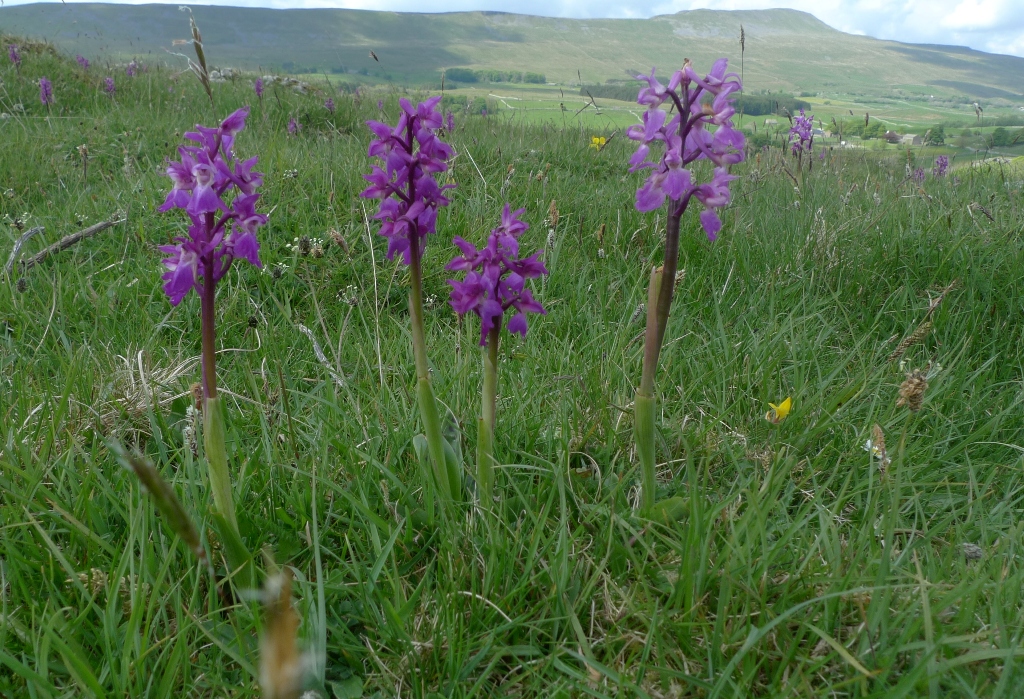
This long-lived tuberous perennial herb is found on thin calcareous soils, typically over chalk but also on clay, ragstone and Carboniferous limestone. It grows in open Corylus, Fagus or Fraxinus woodland and scrub and, more rarely, in open grassland.
Orchis purpurea may be mistaken for the military orchid (Orchis militaris) or monkey orchid (Orchis simia). The three species often hybridize, making them difficult to identify, although the shape of the labellum is distinct to each species.
Deer, especially the muntjac, and slugs are among the greatest threats to this orchid. Human activity – woodland clearance, picking flowers or uprooting plants – is a major concern.
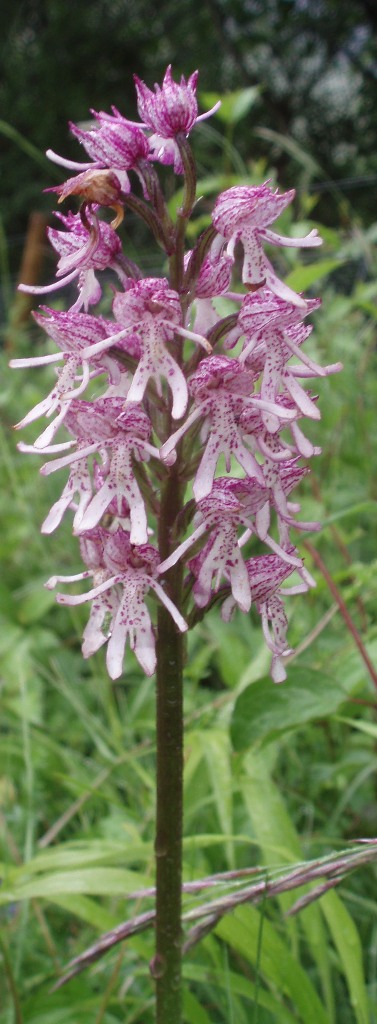
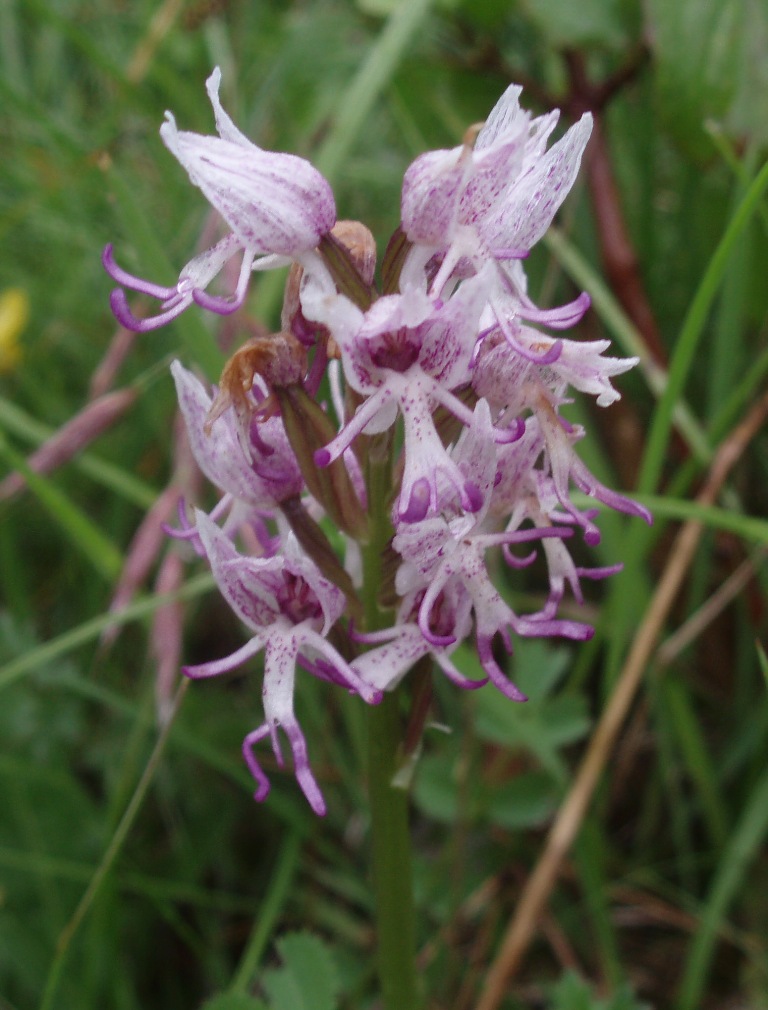
Both found at Hartslock in Oxfordshire: O. simia as well as the cross between O. purpurea and O. simia = O. angusticruris (pictures by M.P.)
This perennial, tuberous herb is found on S.-facing banks in grazed chalk grassland. It is tolerant of some degree of shade from scrub, and can also grow on woodland edges.
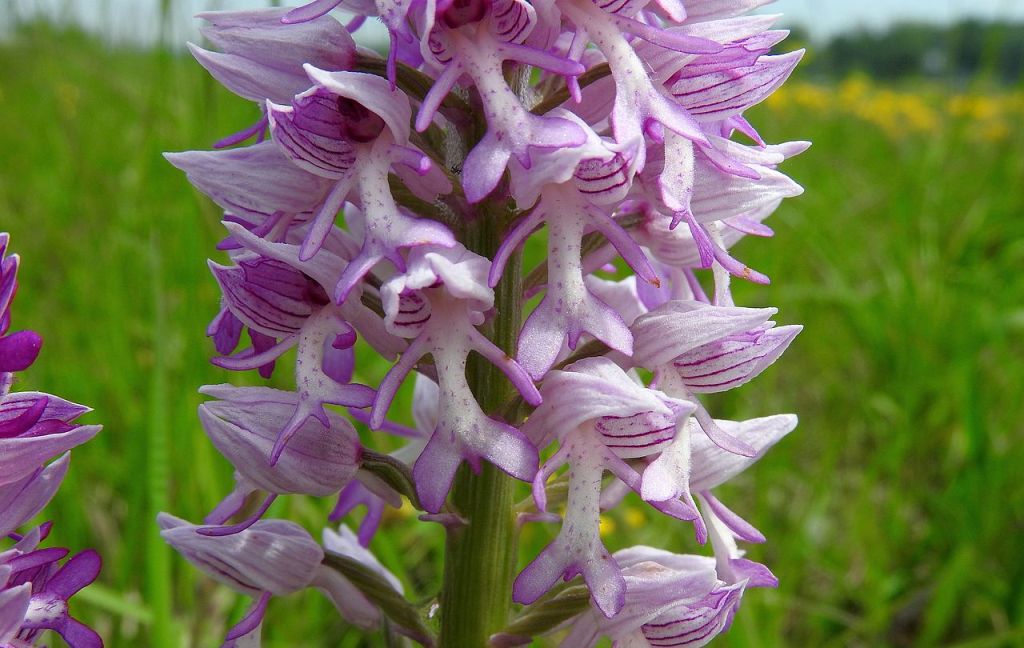
A tuberous perennial herb found on chalk in grassland, scrub, woodland glades and a chalk-pit. It was planted on industrial waste ground in S. Lancashire, and in new sites in Cambridgeshire and Kent.
Uses in the 18th and 19th centuries:
Orchis militaris contains the nutritious polysaccharide glucomannan, and is one of the original species of orchid whose ground-up roots are used to make the drink salep
This tuberous perennial herb requires warm, dry conditions and is often found in tightly grazed chalk and limestone grassland on S.-facing slopes. It also occurs on sandy and gravelly soils in river meadows and on sand dunes.
The early-flowering subspecies Neotinea ustulata var. ustulata is pollinated by a tachinid parasitic fly Tachina magnicornis. The late-flowering subspecies Neotinea ustulata var. aestivalis is pollinated by the longhorn beetle Pseudovadonia livida and possibly also by bees.
As this species is one of the smallest European orchids, it generally relies on low intensity grazing to compete with other plants for light. It is however, not spared by grazers; above ground, plants may be eaten by sheep, cows, rabbits, slugs and snails.
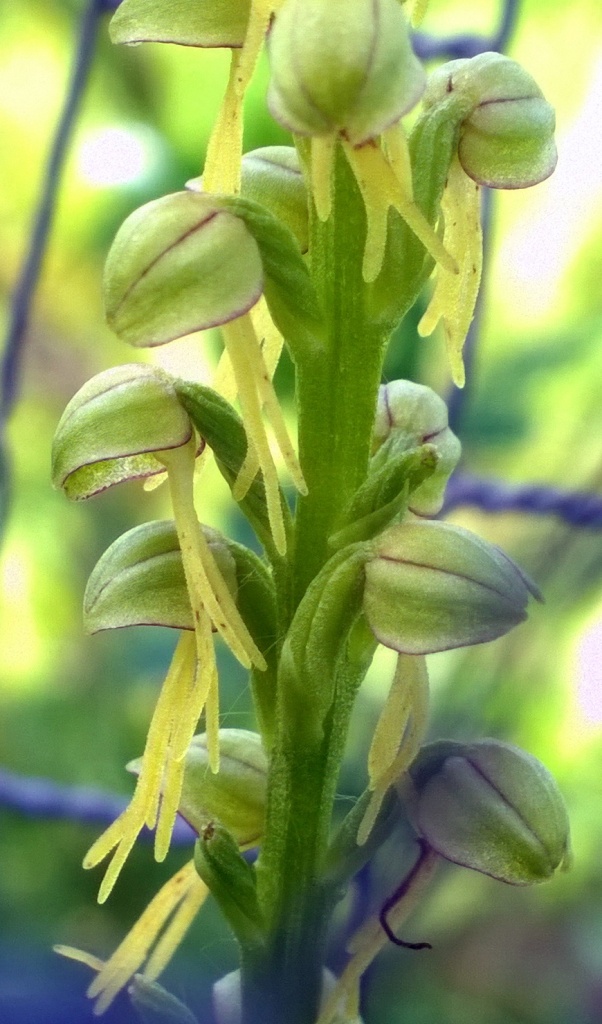
This tuberous perennial herb is found in old chalk-pits and limestone quarries, calcareous grassland and on road verges. It tolerates considerable shade and is often found at the edge of scrub with grasses such as Brachypodium pinnatum. Continuous heavy grazing is detrimental, eventually causing its demise.
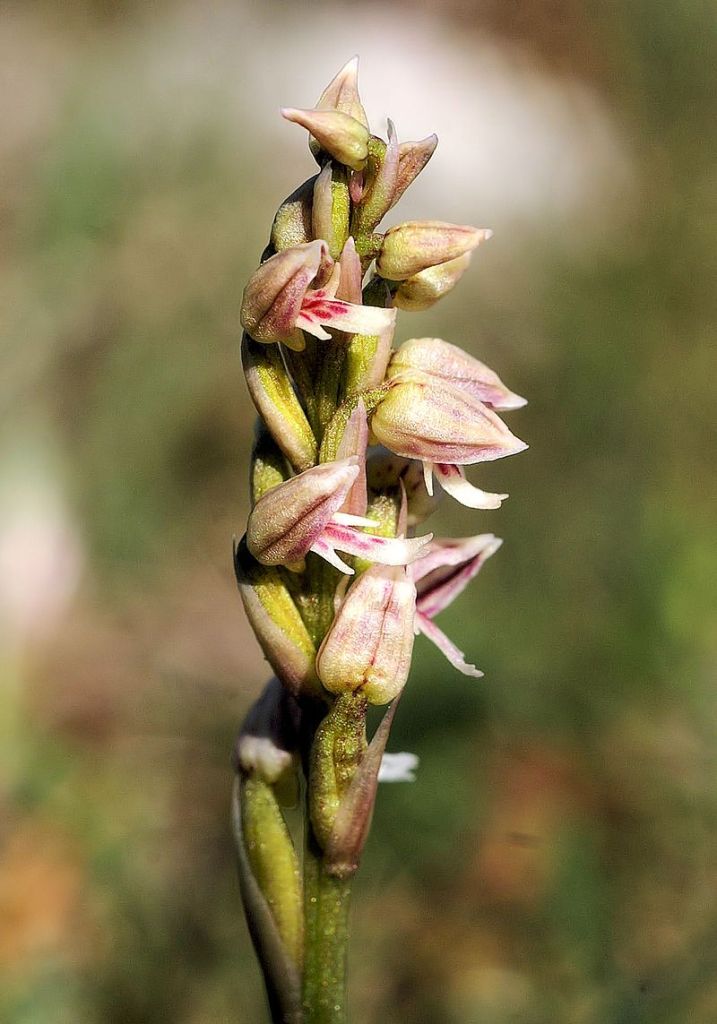
Neotinea maculata or dense-flowered orchid
This tuberous perennial herb grows in a wide range of habitats on base-rich rocky or gravelly substrates. It can be found in the crevices of limestone pavement, in old pastures, hill grasslands, dunes and on road verges. Occasionally, it occurs on peat overlying more acidic rocks, and in Corylus-Fraxinus woodland.
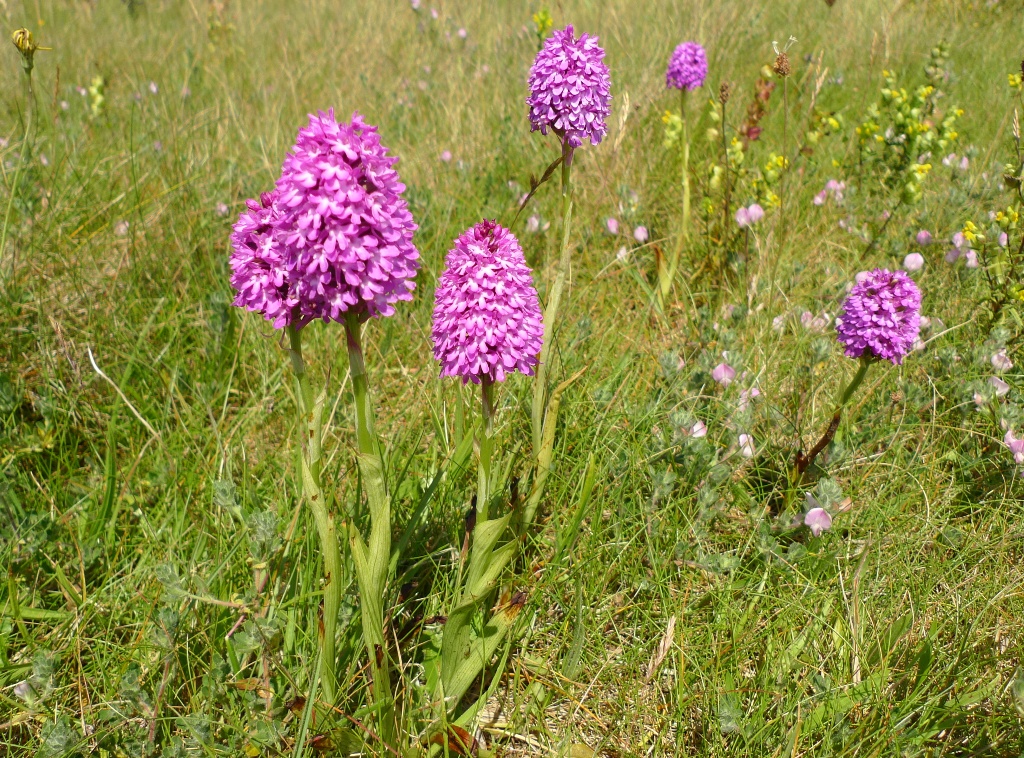
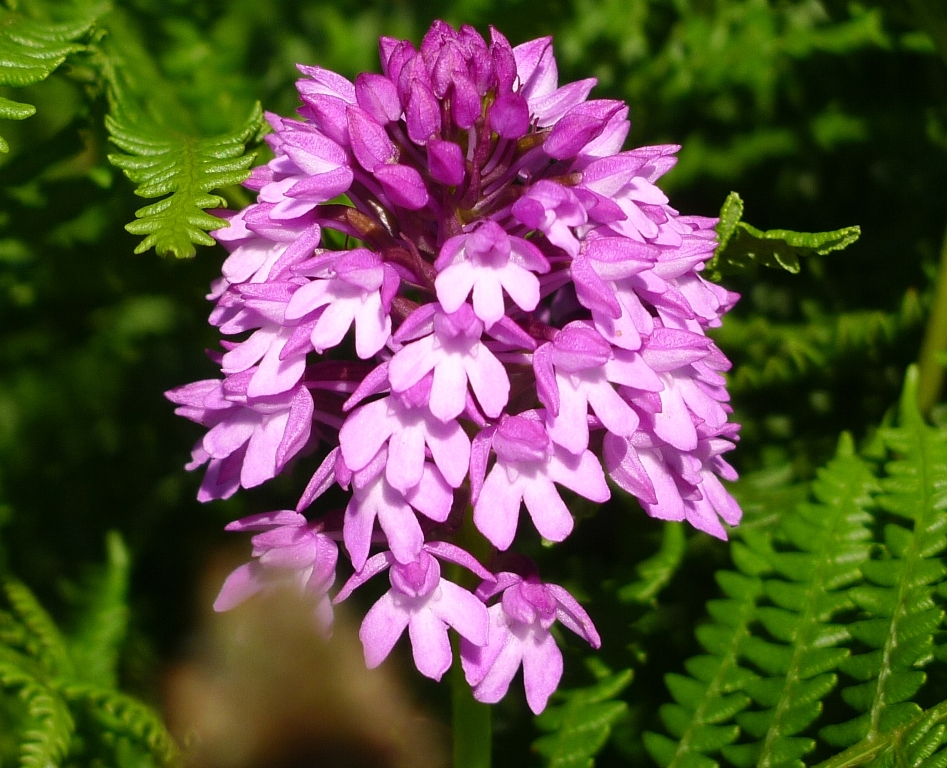
Anacamptis pyramidalis or Pyramidal orchid
A tuberous perennial herb of well-drained calcareous soils. It is found in shortly grazed downland, dune-slacks and on cliff-tops, and also in the longer grass of semi-stable dunes, scrub, roadside verges and churchyards. It also grows in the grikes of limestone pavement, and can colonise the disturbed ground of abandoned quarries, industrial waste land and railway embankments.
The flowers are pollinated by butterflies and moths. To ensure the fertilization, their morphology is well adapted to the proboscis of Lepidoptera, especially Euphydryas, Melanargia, Melitaea , Pieris and Zygaena species. The mechanism by which its pairs of pollinia attach themselves to an insect’s proboscis was discovered by Charles Darwin and described in his book on the Fertilisation of Orchids
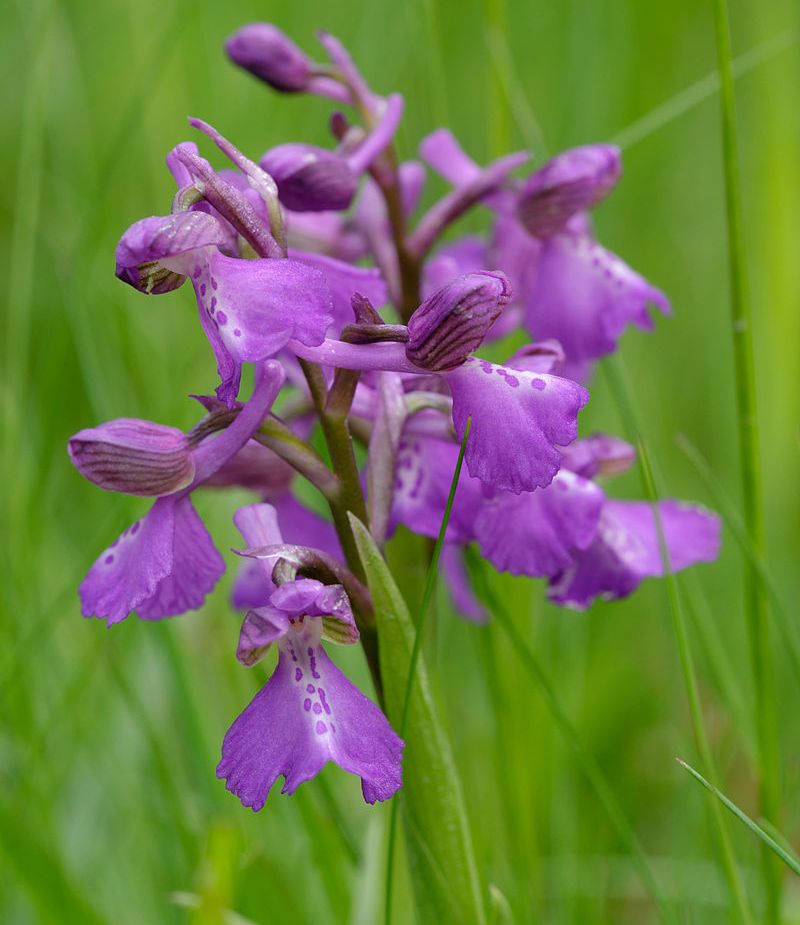
Anacamptis moria or Green-winged Orchid
A tuberous perennial herb of damp to dry, base-rich to mildly acidic soils. It is most frequent in hay meadows and pastures, but also grows on sand dunes, heaths and roadsides, and in quarries, gravel-pits, churchyards and lawns.
This is similar in appearance to the early purple orchid Orchis mascula, which flowers around the same time of year, but Anacamptis morio has green stripes on the two lateral sepals, and lacks the spots or blotches of the Early Purple’s leaves.
Pollination and Conservation status:
Pollination is by bees. The flowers do not produce nectar, but can attract pollinators with their visual appearance. This nectar deception “facilitates the mixing of pollen between different individual plants, promotes genetic diversity in the species, and has been favored evolutionarily over nectar production.
This species’ conservation status is vulnerable and near threatened. It is a protected species in Northern Ireland under the Wildlife (NI) Order of 1985.
In 2001 Anacamptis morio was adopted as the logo for Priory Vale, the third and final instalment in Swindon’s ‘Northern Expansion’ project. Due to a rapid decline in the species they are protected in certain cases, although still regarded as being quite common in the Swindon area, especially Clifford Meadow, a Site of Special Scientific Interest (SSSI) off Thamesdown Drive, Swindon.
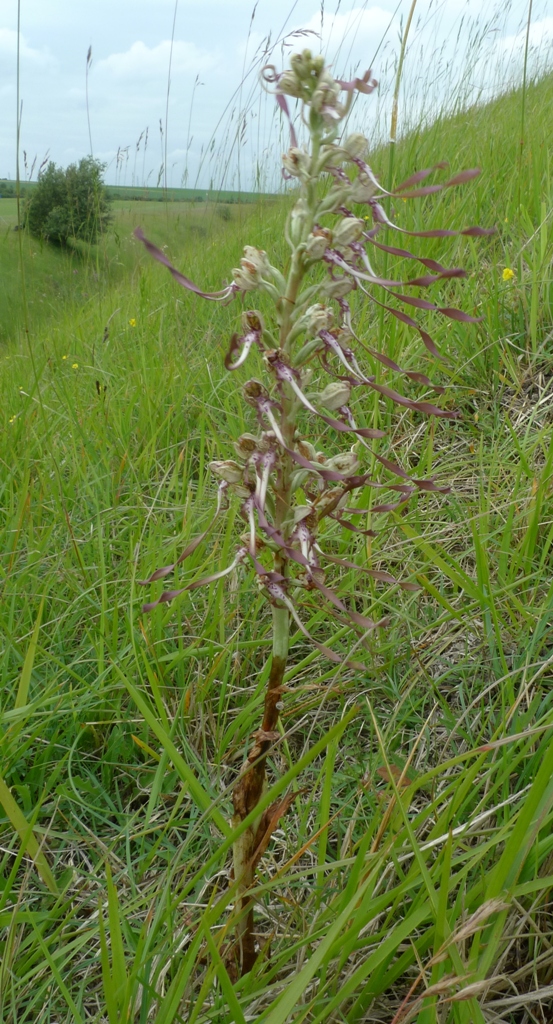
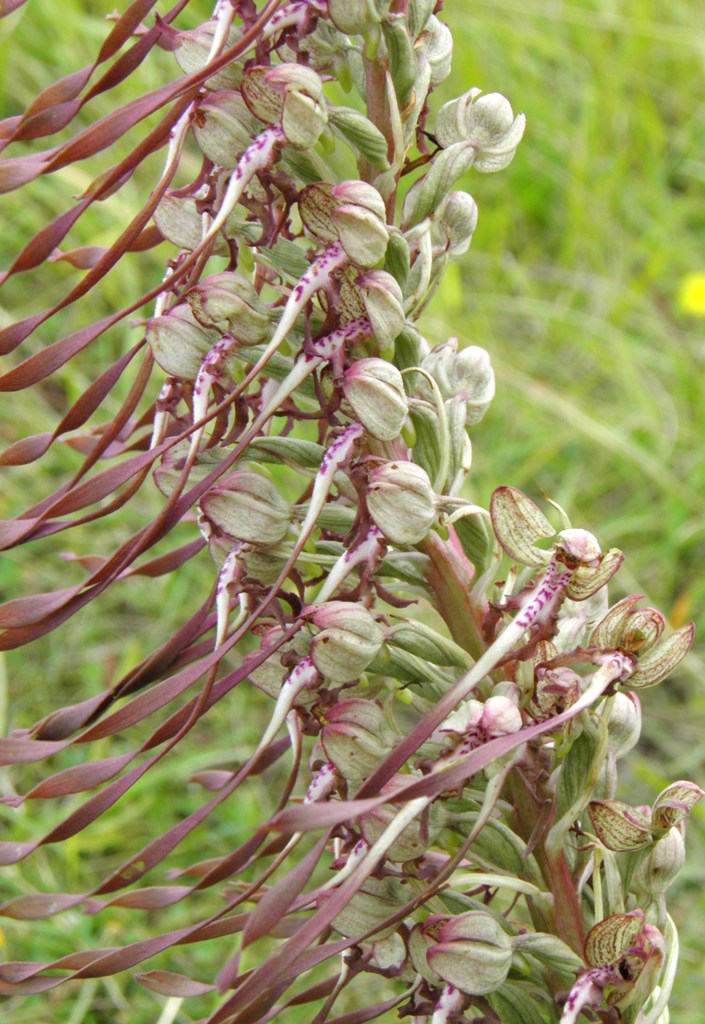
The Lizard orchid – Pictures taken at Devil’s Dyke, Newmarket (by M.P.)
himantoglossum hircinum or lizard orchid
A tuberous, winter-green perennial herb growing on chalk and, rarely, limestone in open grassland, on roadsides and in quarries, and occasionally on calcareous sand dunes and heathland.
Himantoglossum hircinum is a food-deceptive orchid species, meaning the flowers generally provide no nectar to their pollinators. The Botanical Society of Britain and Ireland states however that some plants have been found to provide nectar to pollinators, and that it remains unclear which species are the principal pollinators of the lizard orchid, although they suggest Andrena bees
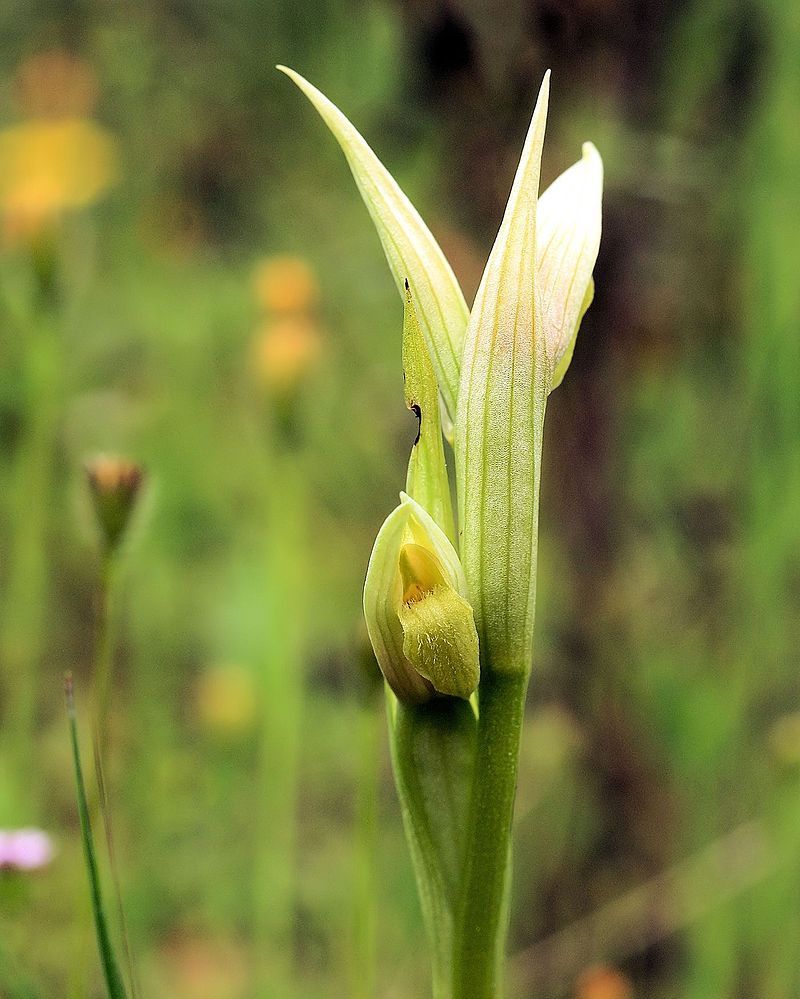
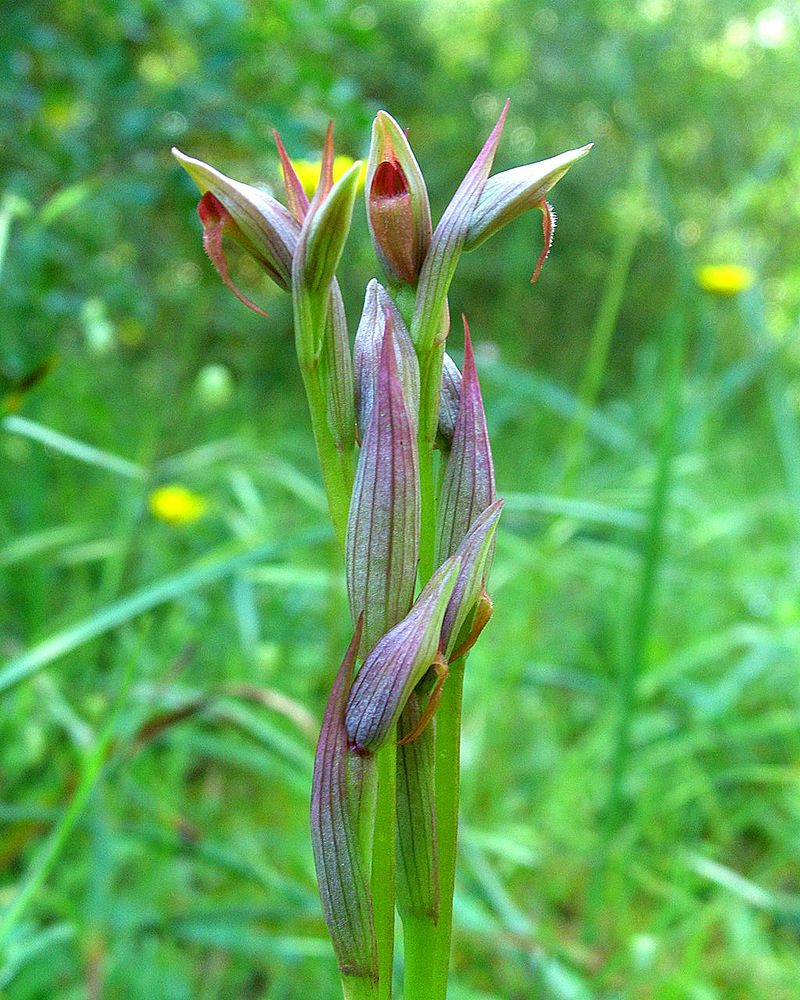
Lesser tongue-orchid white form and usual form (both by Orchi in Wikipedia)
Serapias parviflora or Lesser tongue-orchid
A small, tuberous perennial herb found growing in rabbit grazed grassland in Ulex europaeus and Rubus fruticosus agg. scrub on S.-facing coastal cliffs.
Several Serapias species have been recorded for Britain, and this is perhaps the most convincingly native. It was first discovered in 1989, and the single known population flowered intermittently until 1998. It may have arisen from wind blown seed and is regarded as native by Madge (1994) and Rich (1997c), but Stace (1997) and Lang (in Rich & Jermy, 1998) are more cautious and regard it as alien.
This is an entomophilous plant, but cannot offer floral rewards to pollinators as it does not produce nectar. Therefore, pollinators are just attracted by the shape of the flower, forming a small tube used by insects to rest by night or as a refuge against the rain. In this process pollen gets stuck to the pollinators’ bodies. Once they leave their shelter, they will deposit the pollen on other flowers and fertilize them. These orchids are mainly pollinated by some beetles (families Oedemeridae and Lymexylidae) and by bees (genera Ceratina, Eucera and Osmia). Seeds are dispersed by the wind (anemochory).
Ophrys spp or bee orchids
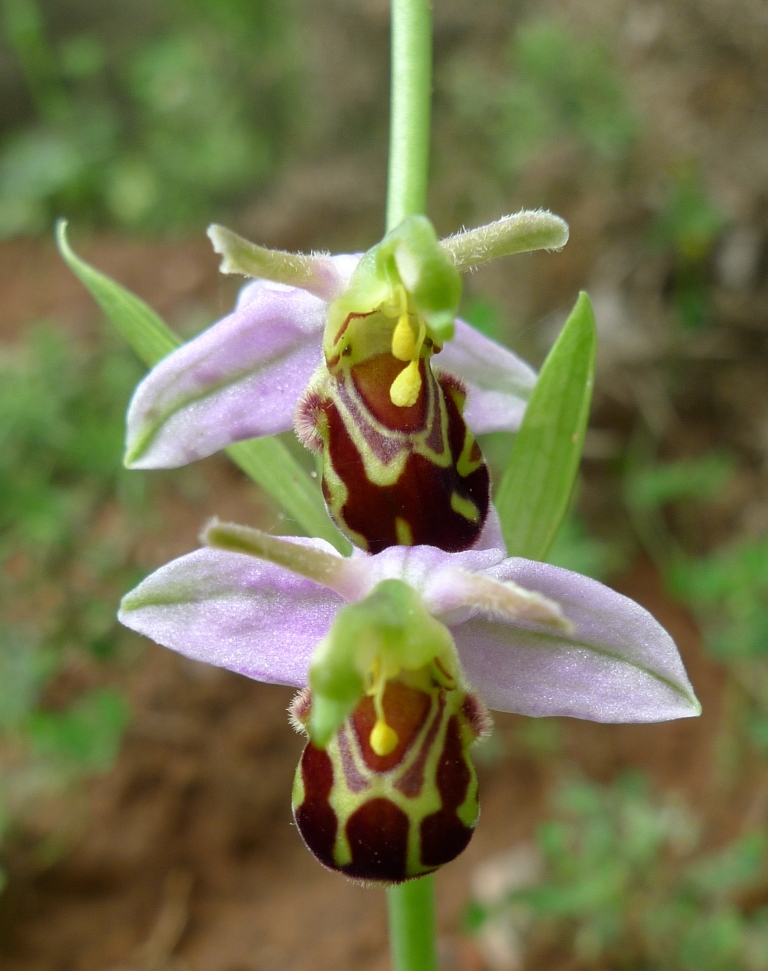
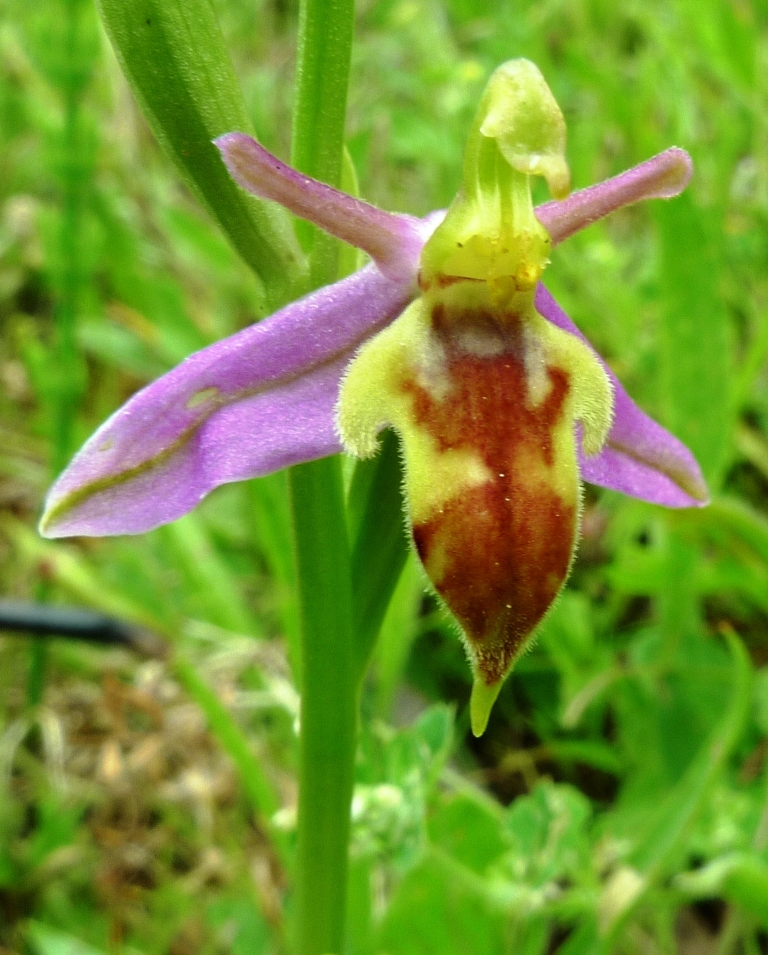
Two types of Bee Orchid seen at Dunsley Quarry, Stourton (pictures by M.P.)
A tuberous perennial herb of calcareous, well-drained soils. Habitats include grasslands, scrub, railway banks, roadsides, lawns, sand dunes and limestone pavement; also disturbed sites such as quarries, gravel-pits and industrial waste ground.
Ophrys apifera has been considered to preferentially practice self-pollination. The flowers are almost exclusively self-pollinating in the northern ranges of the plant’s distribution, however pollination by the solitary bee Eucera longicornis occurs in the Mediterranean region, where Ophrys apifera is more common. E. longicornis males have been observed attempting to copulate with the flowers, which emit allomones that mimic the scent of the female bee. These allomones are also known to attract bee species Tetralonia cressa and Eucera pulveraceae. In addition to chemosensory mimicry, the labellum of the flower acts as a visual decoy that the male bee confuses for a female. It is believed that male bees preferentially select orchids with the most bee-like labellum and attempt copulation, at which point the pollinia stick to the bee during the pseudocopulation. This achieves pollen transfer and, potentially, pollination.
Bee orchids are threatened by mowing during flowering, or before the seed has been released. However, they often also disappear from sites that become overgrown with shrubs and/or trees, as the orchids fail to compete with these large plants for light. For these reasons, bee orchids are often found on the edge of mown areas, beside paths or within areas that are mown very infrequently.
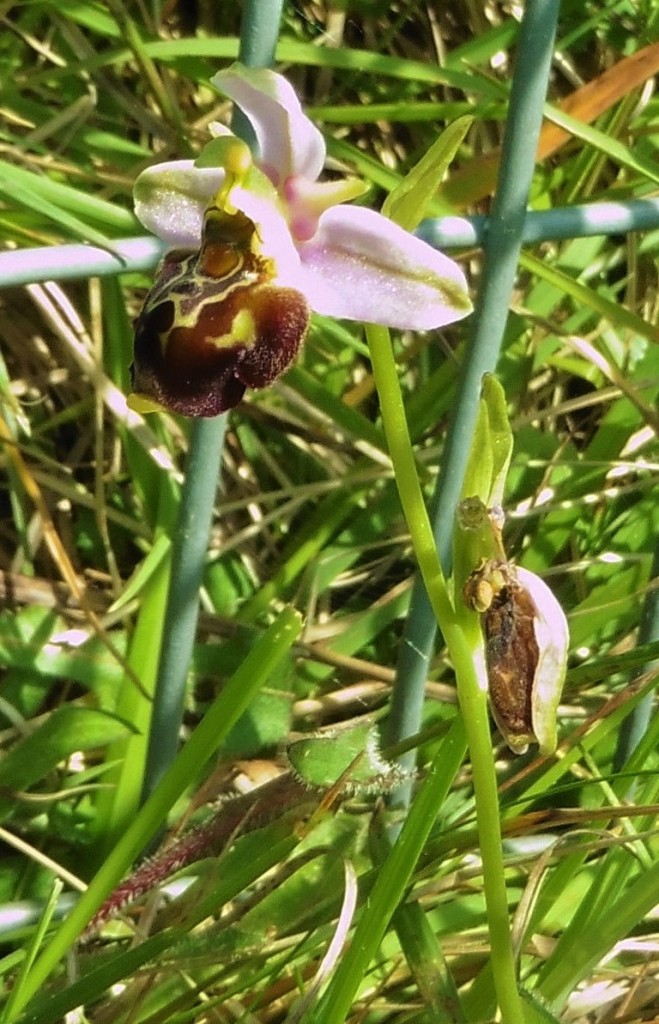
This long-lived, tuberous perennial herb grows on well-drained calcareous, chalky soil in species-rich, closely grazed grassland; it cannot compete in longer grassland. Some colonies are on previously disturbed areas, but rarely spread to adjacent sites.
The flowers are pollinated by insects in Europe including bees of the Eucera genus, but little is known about pollinators in the UK except that the occurence of hybrids with other species confirms their presence.
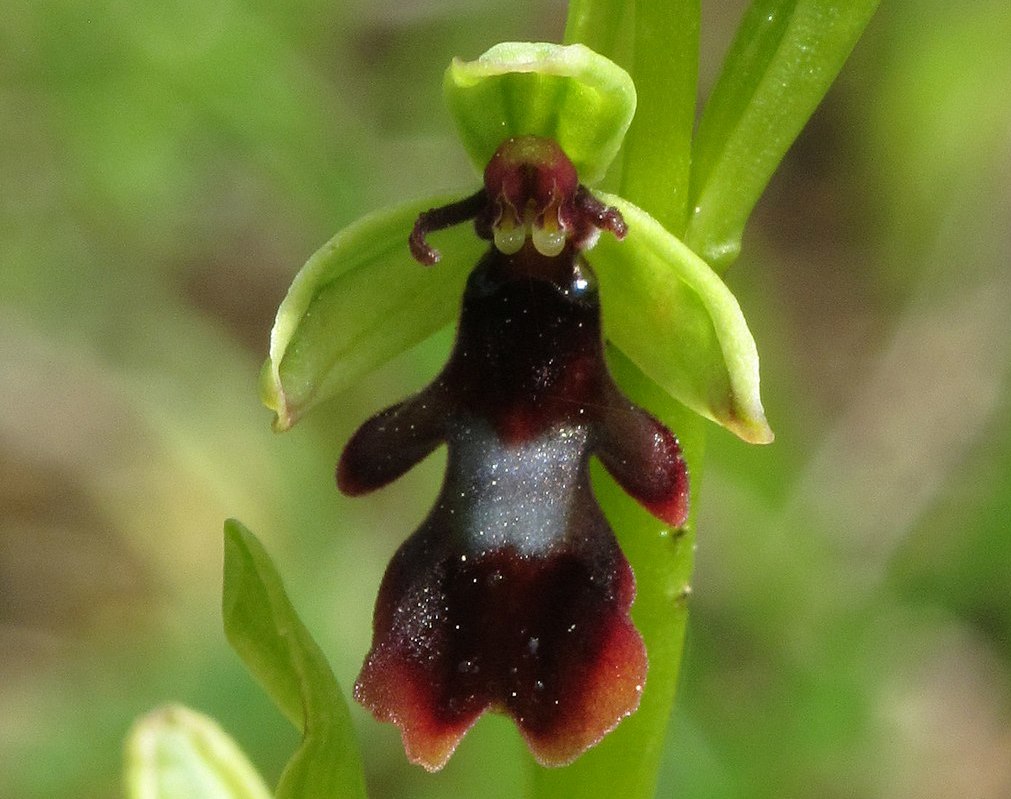
A shade-tolerant tuberous herb usually found on chalk and limestone soils in open deciduous woodland and scrub, but also recorded from grassland, chalk-pits, limestone pavement, disused railways, spoil heaps and, rarely, unstable coastal cliffs. In Ireland and Anglesey it is found only in open calcareous flushes and fens.
The name arises because its inflorescence resembles a fly, although it is dependent on Hymenoptera for pollination. In the UK O. insectifera is pollinated by just two species of digger wasp: Argogorytes mystaceus and Argogorytes fargeii. The plants use scent to attract male wasps which pollinate the flowers as they attempt to mate with them. The scent released by the flowers mimic female sexual pheromones.
In Great Britain its conservation status is ‘vulnerable’. This species is mainly threatened by habitat destruction, which takes several forms: drainage of fens, coniferisation of woodland and decline in coppicing of woodland. As it has a very specialised relationship with its pollinators it is also theorised to be particularly vulnerable to climate change

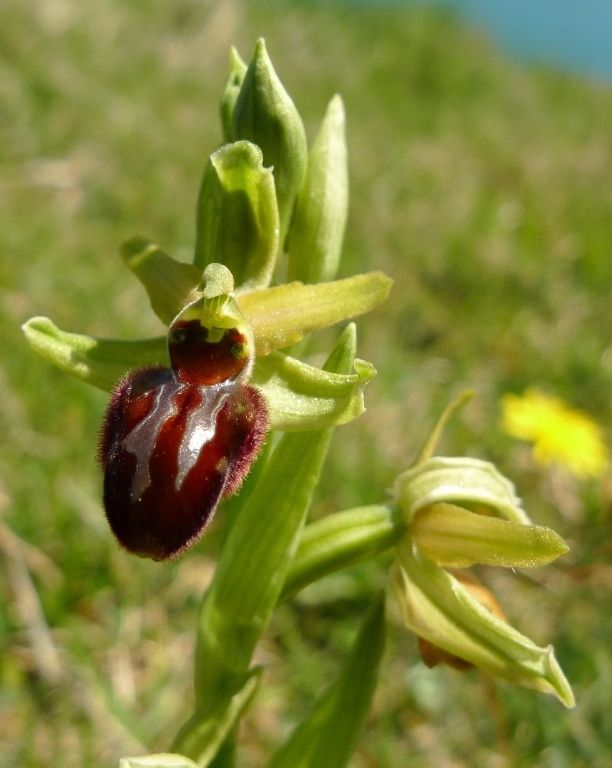
- O. speghodes or EarlySpider-orchid
A winter-green, short-lived perennial tuberous herb of ancient, species-rich, heavily grazed grassland on chalk and Purbeck limestone. It can, however, tolerate taller grassland, and has also been found colonising disturbed ground in limestone quarries, old spoil heaps and by tracks.
In the UK Ophrys sphegodes is pollinated by the miner bee Andrena nigroaenea, a polylectic pollinator (i.e. one that visits many different species of flower), a bee species which requires dry sandy soils. Different subspecies have evolved to attract different pollinators.
In the latest Stace it mentions two more species of Ophrys:
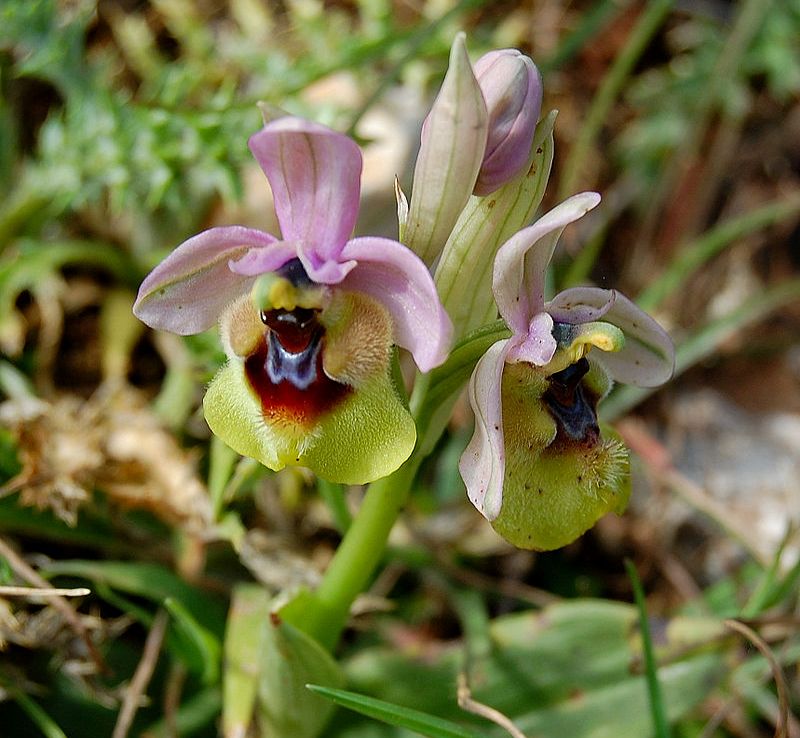
O. tenthredinifera or Sawfly-orchid
According to both website links this beautiful orchid is found mainly in the western and central Mediterranean region, becoming more scarce as you travel east.
Also the cross between O. insectifera x O. apifera is given a binomial O. x pietzschii.
Found in calcareous grassland on three sites only; Selsley Common in Gloucestershire, near Arundel in West Sussex, and at Maperton Ridge in Somerset.
From time to time hybrids occur between wild orchids, and they are nearly always between closely related species. Because of the enormous variation which naturally occurs in orchid flowers it is sometimes difficult to decide if an unusual looking flower is truly a hybrid or just the subject of variation or mutation within a single species.
Another difficulty in accurate identification of wild orchid hybrids is that some orchids with the same parents may look entirely different and this can result from the direction of the cross: in the case of Bee Orchid x Fly Orchid it is assumed that the Bee Orchid was pollinated by an insect travelling from the Fly Orchid and not the other way around.
